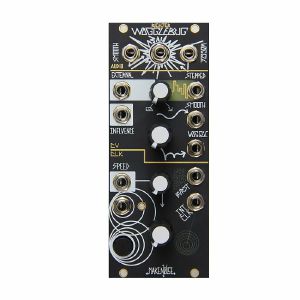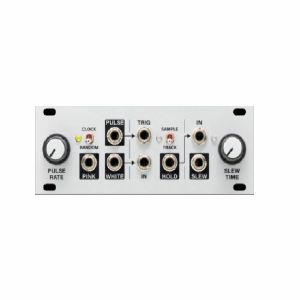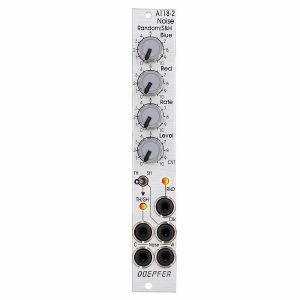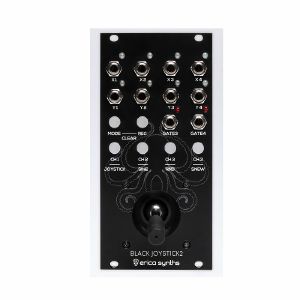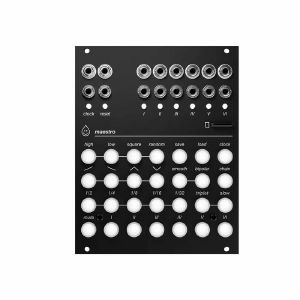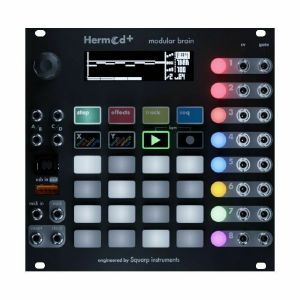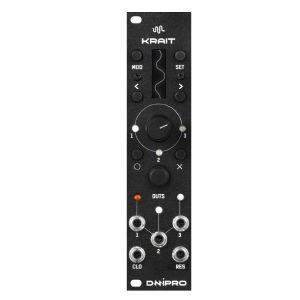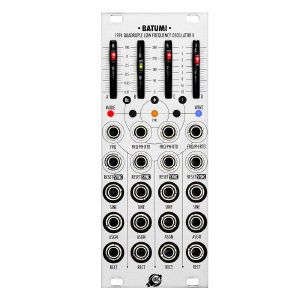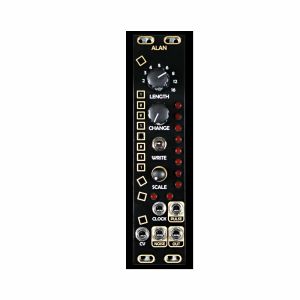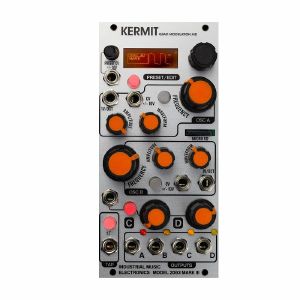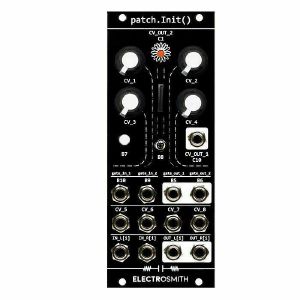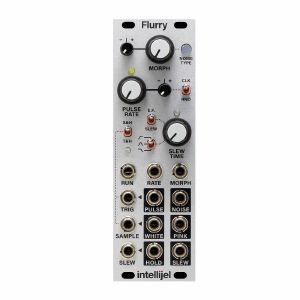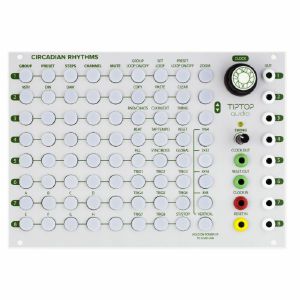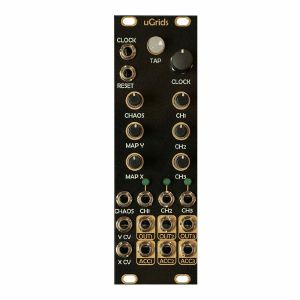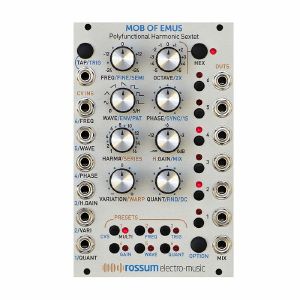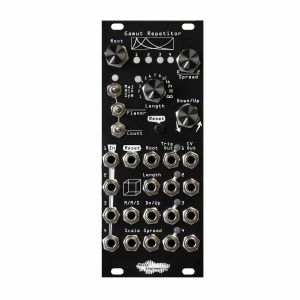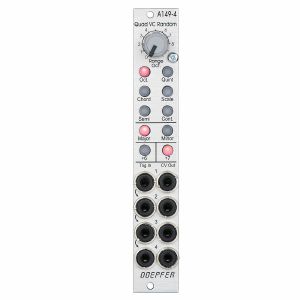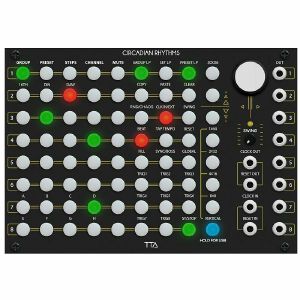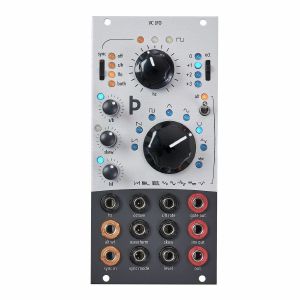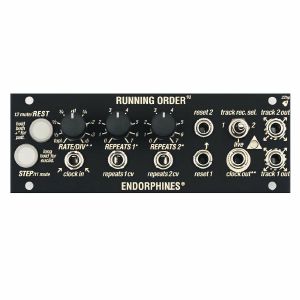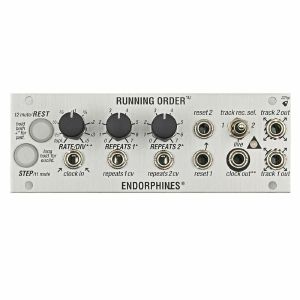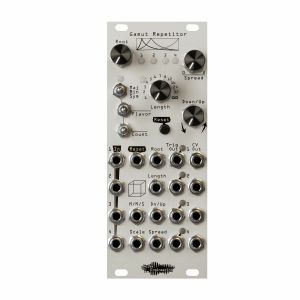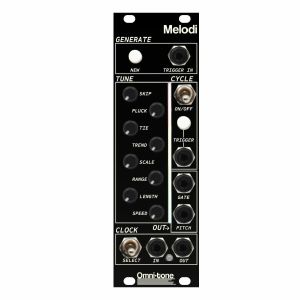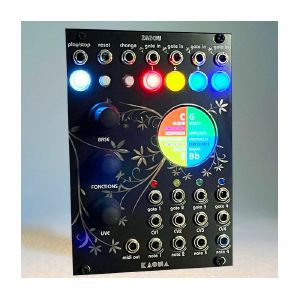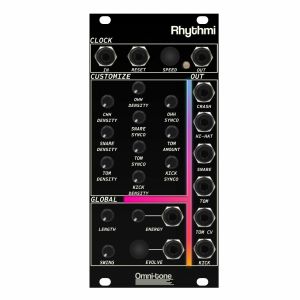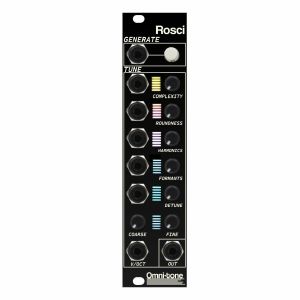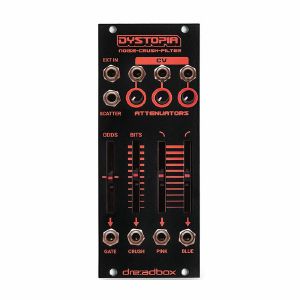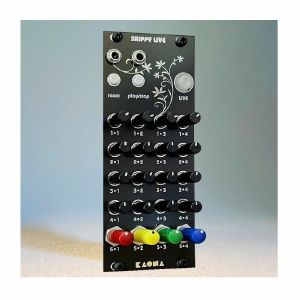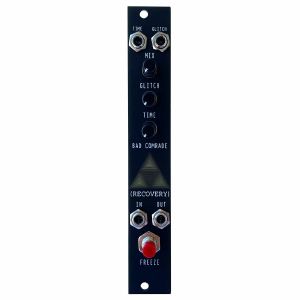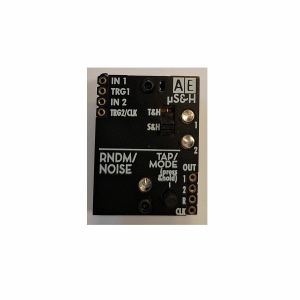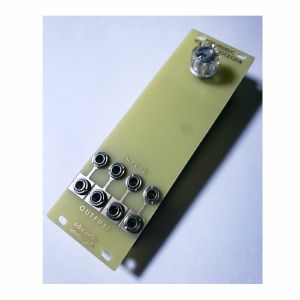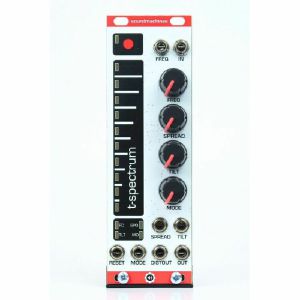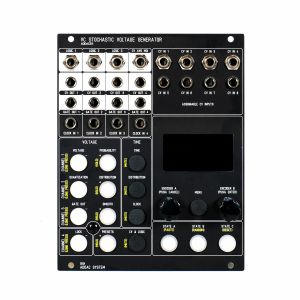Filter
Equipment
Format
Brand
Featured
Price
Tags
Tags: Random module
Products tagged as Random module
Artikel 1 bis 37 von 37 auf Seite 1 von 1 anzeigen
Qu-Bit Bloom Fractal Sequencer Module (sequencer synth module)
Cat: 740273 Rel: 02 Oct 19
A fractal sequencer capable of generating infinitely evolving melodies with a host of musical features.
Notes: If we're honest we don't really understand fractals. Something to do with maths, apparently. But that doesn't really matter because we do understand this sequencer module, which is ideal for randomly twisting and morphing sequences.
Supplier notes:
Bloom is a fractal sequencer capable of generating infinitely evolving melodies with a host of musical features.
At its core is a powerful 32 step sequencer with two independent channels and an intuitive interface. What makes the Bloom come alive are its fractal algorithms which can transform existing sequences into powerful melodies, or even generate new patterns altogether. The base sequence is known as the Trunk and can be programmed by hand, or automatically generated with the Mutate function. Once a Trunk sequence is in place, fractal transformations are only a knob turn away by using the Branch and path controls. Each new Branch adds a complete variation to the base sequence and Path determines its passage through the set of recursively generated sub-sequences, offering a unique take on the melody with each turn of the knob.
Bring your sequencing to life with Bloom.
… Read moreSupplier notes:
Bloom is a fractal sequencer capable of generating infinitely evolving melodies with a host of musical features.
At its core is a powerful 32 step sequencer with two independent channels and an intuitive interface. What makes the Bloom come alive are its fractal algorithms which can transform existing sequences into powerful melodies, or even generate new patterns altogether. The base sequence is known as the Trunk and can be programmed by hand, or automatically generated with the Mutate function. Once a Trunk sequence is in place, fractal transformations are only a knob turn away by using the Branch and path controls. Each new Branch adds a complete variation to the base sequence and Path determines its passage through the set of recursively generated sub-sequences, offering a unique take on the melody with each turn of the knob.
Bring your sequencing to life with Bloom.
1 in stock $336.35
Make Noise Richter Wogglebug Random Voltage Generator Module (random/clock generator/oscillator/ring modulator/sample & hold/slew limiter module)
Cat: 557451 Rel: 19 Dec 14
Random voltage generator module - 10HP
Notes: The WoggleBug music synthesizer module is a random voltage generator, originally designed by Grant Richter of Wiard Synthesizers. It is a continuation of the "smooth" and "stepped" fluctuating random voltage sources pioneered by Don Buchla within the Model 265 "Source of Uncertainty," expanding it to include the other-worldly Woggle CVs (stepped voltages with decaying sinusoids edges). The Wogglebug is a very musical random voltage generator where it is possible to synchronize all random signal to a Master Clock. Guaranteed to unleash your synthesizer's ID MONSTER!
Features:
Complete Complex Random Voltage system, no external modules necessary
Two VCOs, Phase Lock Loop, Lag Processor, Clock, Burst Generator and Sample & Hold
Generates 7 Random Signals simultaneously: Smooth VCO, Woggle VCO, Ring Mod, Stepped, Smooth, Woggle, Burst
Generates voltage controlled Master Clock
External inputs for S&H (Heart IN) and Ring-Mod (Influence)
Disturb button adds performance element
Wonderful for modulating the Morphagene and DPO
Specifications:
Width: 10hp
Max Depth (incl. power cable): 32mm
Power: 50mA@ +12V; 40mA @ -12V
… Read moreFeatures:
Complete Complex Random Voltage system, no external modules necessary
Two VCOs, Phase Lock Loop, Lag Processor, Clock, Burst Generator and Sample & Hold
Generates 7 Random Signals simultaneously: Smooth VCO, Woggle VCO, Ring Mod, Stepped, Smooth, Woggle, Burst
Generates voltage controlled Master Clock
External inputs for S&H (Heart IN) and Ring-Mod (Influence)
Disturb button adds performance element
Wonderful for modulating the Morphagene and DPO
Specifications:
Width: 10hp
Max Depth (incl. power cable): 32mm
Power: 50mA@ +12V; 40mA @ -12V
1 in stock $242.31
Intellijel Noise Tools 1U Clock/Random Pulse/Analogue Noise/Sample & Hold/Slew Module (clock generator/noise/random/sample & hold/slew limiter synth module)
Cat: 643383 Rel: 27 Mar 17
Utility module featuring Clock, Random Pulse, Analog Noise, Sample/Hold & Slew
Notes: Noise Random Tools comprises a collection of useful utility blocks that you could use in many of your patches - Clock, Random Pulse, Analog Noise, Sample and Hold, and Slew.
Features:
- Clock and Random pulse source with adjustable rate
- Analog pink and white noise source with very accurate spectrum
- Analog sample / track and hold with very low droop
- Analog slew with adjustable slew rate
… Read moreFeatures:
- Clock and Random pulse source with adjustable rate
- Analog pink and white noise source with very accurate spectrum
- Analog sample / track and hold with very low droop
- Analog slew with adjustable slew rate
1 in stock $111.74
Click for better price!
or call +44 20 7424 1960
quote 643383
quote 643383
Doepfer A-118-2 Noise/Random/Sample & Hold Module (silver, slim line series) (noise/random/sample & hold synth module)
Cat: 731938 Rel: 10 Jun 19
Noise, random, sample & hold module - 4HP
Notes: Module A-118-2 is the slim version of module A-118-1 and offers essentially the same features as the A-118-1. But the distances between the controls are smaller and rubberized small-sized knobs are used. In return the front panel has 4 HP only which is half the width of the A-118-1. The module is primarily planned for applications where only limited space is available. The functional difference between A-118-1 and A-118-2 is the additional T&H/S&H unit which is not included in the A-118-1.
The module generates the signals white noise, colored noise, continuous random voltage and stepped random voltage (derived from the continuous random voltage by means of a S&H/T&H unit).
The noise signal is generated 100% analog by amplification of the noise of a transistor. White and colored noise are usually used as audio sources. The random voltages are normally used as control voltages (e.g. for filter frequency or any other voltage controlled parameter).
The A-118-2 gives you the ability to mix the relative amounts of Red (low frequency component) and Blue noise (high frequency component) in the colored noise output.
For the continuous random voltage the rate of change (Rate) and amplitude (Level) of the random voltage can be adjusted. The continuous random voltage is derived from the colored noise signal by low pass filtering. Consequently the settings of the controls for the colored noise (Blue, Red) affect the behavior of the random voltage! A dual color LED (red = positive / yellow = negative output voltage) indicates the continuous random voltage.
The continuous random voltage is used as source for the S&H/T&H unit. The type of operation can be set to S&H (sample and hold) or T&H (track and hold). When T&H is chosen the output signal follows the input signal (= continuous random voltage) as long as the Clock input is "high". As soon as the clock signal changes to "low" the last voltage is stored. When S&H is chosen the input signal (= continuous random voltage) is sampled at the rising edge of the Clock signal.
For the Clock signal a "digital" signal (e.g. Clock, Gate, rectangle output of an LFO) is required. It does not work with slowly changing continuous CV signals. Another dual color LED (red = positive / yellow = negative output voltage) indicates the stepped random voltage.
Controls:
Blue: share of the high frequencies in the the colored noise output
Red: share of the low frequencies in the the colored noise output
Rate: rate of change of the continuous random voltage
Level: amplitude of the continuous random voltage
TH/SH: switches between T&H and S&H
Inputs and outputs:
RND: continuous random voltage output (with LED display)
TH/SH: stepped random voltage output (with LED display)
Clk: Clock input of the S&H/T&H unit
C Noise: colored noise output
W Noise: white noise output
Important notes:
After power on it takes a few minutes until the two noise signals and the random signals are generated. The module is not faulty when after power on the signals do not appear immediately!
The S&H/T&H function is realized by pure analog circuitry (electronic switch followed by a holding capacitor and buffer). Consequently the output voltage drifts a bit in the holding state because the capacitor is discharged by parasitic resistors. The drift depends also upon environmental conditions like humidity or temperature.
Dimensions
4 HP
40 mm deep
Current Draw
20 mA +12V
20 mA -12V
… Read moreThe module generates the signals white noise, colored noise, continuous random voltage and stepped random voltage (derived from the continuous random voltage by means of a S&H/T&H unit).
The noise signal is generated 100% analog by amplification of the noise of a transistor. White and colored noise are usually used as audio sources. The random voltages are normally used as control voltages (e.g. for filter frequency or any other voltage controlled parameter).
The A-118-2 gives you the ability to mix the relative amounts of Red (low frequency component) and Blue noise (high frequency component) in the colored noise output.
For the continuous random voltage the rate of change (Rate) and amplitude (Level) of the random voltage can be adjusted. The continuous random voltage is derived from the colored noise signal by low pass filtering. Consequently the settings of the controls for the colored noise (Blue, Red) affect the behavior of the random voltage! A dual color LED (red = positive / yellow = negative output voltage) indicates the continuous random voltage.
The continuous random voltage is used as source for the S&H/T&H unit. The type of operation can be set to S&H (sample and hold) or T&H (track and hold). When T&H is chosen the output signal follows the input signal (= continuous random voltage) as long as the Clock input is "high". As soon as the clock signal changes to "low" the last voltage is stored. When S&H is chosen the input signal (= continuous random voltage) is sampled at the rising edge of the Clock signal.
For the Clock signal a "digital" signal (e.g. Clock, Gate, rectangle output of an LFO) is required. It does not work with slowly changing continuous CV signals. Another dual color LED (red = positive / yellow = negative output voltage) indicates the stepped random voltage.
Controls:
Blue: share of the high frequencies in the the colored noise output
Red: share of the low frequencies in the the colored noise output
Rate: rate of change of the continuous random voltage
Level: amplitude of the continuous random voltage
TH/SH: switches between T&H and S&H
Inputs and outputs:
RND: continuous random voltage output (with LED display)
TH/SH: stepped random voltage output (with LED display)
Clk: Clock input of the S&H/T&H unit
C Noise: colored noise output
W Noise: white noise output
Important notes:
After power on it takes a few minutes until the two noise signals and the random signals are generated. The module is not faulty when after power on the signals do not appear immediately!
The S&H/T&H function is realized by pure analog circuitry (electronic switch followed by a holding capacitor and buffer). Consequently the output voltage drifts a bit in the holding state because the capacitor is discharged by parasitic resistors. The drift depends also upon environmental conditions like humidity or temperature.
Dimensions
4 HP
40 mm deep
Current Draw
20 mA +12V
20 mA -12V
1 in stock $91.82
Click for better price!
or call +44 20 7424 1960
quote 731938
quote 731938
Erica Synths Black Joystick2 4-Channel Recordable Joystick Controller Module (controller synth module)
Cat: 812600 Rel: 23 Feb 21
8-channel multi-functional CV source, joystick, movement recorder & distinct LFO module - 12HP
Notes: Multi-function eight-channel LFO, joystick, movement recorder and drone oscillator that packs in lots more functionality than you might expect. A real modulation powerhouse in a compact format.
Supplier's Notes:
Erica Synths Black Joystick2 is 8 channel multi functional CV and sound source - joystick, movement recorder, distinct LFO and drone/noise oscillator. It provides great interaction with the modular system and allows to develop unconventional modulation patterns instantly.
… Read moreSupplier's Notes:
Erica Synths Black Joystick2 is 8 channel multi functional CV and sound source - joystick, movement recorder, distinct LFO and drone/noise oscillator. It provides great interaction with the modular system and allows to develop unconventional modulation patterns instantly.
1 in stock $236.77
Acid Rain Technology Maestro 6-Channel Clocked Modulation Controller Module (clock generator/clock modulator/controller/CV modulation/envelope generator/LFO/random/sequencer module)
Cat: 804571 Rel: 22 Jan 21
6-channel clocked modulation module
Notes: Maestro is a 6 channel clocked modulation controller inspired by the automation lanes found in digital audio workstation software, brought into eurorack and made playable and performable. Maestro will push and pull the parameters of your other modules with rapid or slowly evolving voltages, always in perfect sync with eachother and the rest of your system.
Details:
20hp
25mm deep
65mA on +12, 18mA on -12, 0mA on 5V
… Read moreDetails:
20hp
25mm deep
65mA on +12, 18mA on -12, 0mA on 5V
1 in stock $399.41
Click for better price!
or call +44 20 7424 1960
quote 804571
quote 804571
Squarp Instruments Hermod+ Modular Brain 16-Track MIDI Polyphonic Sequencer Module (sequencer synth module)
Cat: 973086 Rel: 27 Oct 23
16-track MIDI polyphonic sequencer module - 26HP.
Notes: *** Firmware update- February 2025 ***
Hermod+OS2.00
Again, a major firmware upgrade packed with exciting new features. This update offers a wealth of new creative tools and improvements.
Audio tuner
4 internal automation per track - MOD, MOD2, MOD3, MOD4
Automation per track : 7 (4x modulations + pitchbend + aftertouch + sustain
***
Parisian sequencer specialists Squarp turn up the goods once again with the updated Hermod+ module. Huge sequencing power for both MIDI and CV, with a range of monophonic and polyphonic features to get the most out of your sound sources.
Supplier's Notes:
Hermod+ adds so much to your system.
Based on the established Hermod workflow and keeping the same form factor, Hermod+ offers a lot of new features, and a refined, more playful interface with extended connectivity.
Record CV/Gate, MIDI notes and modulations on 16 polyphonic tracks. Compose melodic variations across 16 patterns per track, and take advantage of the advanced step sequencer and the new effects to gain efficiency and creativity in studio and on stage.
8 CV/Gate and 8 MIDI tracks
Hermod+ offers 8 CV/Gate tracks (that can also output midi) and adds 8 dedicated MIDI tracks for your extra gear.
CV inputs
Record, edit and loop analogue modulations or CV/Gate using the 4 CV inputs, and use them to synchronize Hermod+ to an incoming analogue clock.
Record live
With an improved resolution of 96ppqn, record and playback your CV/Gate or MIDI performance seamlessly without any noticeable note shifting, for up to 16 bars per pattern.
Polyphonic step composer
The revisited piano-roll now allows intuitive polyphonic editing. Edit or program chords, melodies and rhythms using the 16 built-in pads for a quick and playful composition process.
Automation
Program or record automated modulations (CV and/or MIDI) for each track, in addition to midi aftertouch, pitchbend and sustain voices.
Dynamic effects
Add up to 8 real-time CV/MIDI effects per track. All effects are non-destructive, so they can be edited at any given time to add some variations to a performance.
Advanced ModMatrix
Use the modulation matrix to link incoming CV or CC messages to effect parameters. Each modulations can be attenuverted and offsetted.
Playable song mode
Build your song structures using up to 16 sequences per project. Play them into a predefined order or launch them manually for improvised performances.
Synchronized project swap
Quickly save and recall your projects on the SD card. Project loading can now be done in sync, without interrupting your performance.
Boosted connectivity.
The missing link between your eurorack system and the rest of your studio.
Editing made simple.
Fluid workflow with a redesigned Step mode
Step mode is where you can edit notes, modulations and gate events. Hermod+ offers quick ways to write melodies and rhythms. Zoom in and out to visualize and edit portions of your track precisely and break free from rigid grid sequencing.
The re-designed piano roll editor makes the vertical and horizontal scrolling easier and faster, while the new "row edit" feature allows for quick chords and drum patterns programming.
Create modulation curves by programming them directly on Hermod+ or by recording incoming signals, and send those curves via CV or MIDI to other parts of your system.
Versatile interface.
Polymorphic layouts for perfect integration
Hermod+ can adapt its voice layout to any patching scenario. Depending on your needs, any track can become a modulation output, a monophonic CV/Gate track, a polyphonic MIDI track...
For a track of CV/Gate note + velocity + aftertouch, or for a polyphonic CV/Gate track, simply group voices using the desired layout.
Take advantage of the 8 dedicated MIDI tracks, that can record and be programmed independently from the 8 CV/Gate tracks. Up to 8 real-time effects per track with creative parameters and generative features. Hermod+ is the canvas, the paint and the brush of your setup.
Specifications
Sequencer
Tracks: 8 CV/Gate + 8 MIDI
Patterns: 16 per track
Recording resolution: 96ppqn
Track length: 1/16 note to 16 bars
Automation per patterns: modulation + pitchbend + aftertouch + sustain
Projects
Amount of projects: unlimited
Tempo: 10 to 280 BPM
Global transpose track: yes
Double project architecture: yes
Song chain length: 64 sequences
Piano roll
Zoom min: /4 (1 step = 1/4 note = 1 beat)
Zoom max: X8 (1 step = 1/128 note)
Note/gate width: 1/32 (1/512 note) to 8 bars
Maximum polyphony per step: 24
Row edit (polyphony editing): yes
Note pitch: C0 to C10
Note velocity: 0 to 127
Synchonization clock speed
Max input rate: 1/96 = 24ppqn
Max output rate: 1/96 = 24ppqn
Input
MIDI: TRS type A + USB host + USB device
CV: 4x [-5V to +5V]
Output
MIDI: TRS (type A) + USB host + USB device
CV: 8x [-5V to +5V]
GATE: 8x [0V / +5V]
Dedicated Clock port
Dedicated Reset port for transport
Power
Note: the use of your eurorack +5V rail is configurable with a switch on the back of Hermod+
Consumption (using +5V rail): -12V 20mA, +12V 20mA, +5V 820mA (add up to +500mA when attaching a controller on USB host)
Consumption (not using +5V rail): -12V 20mA, +12V 400mA (add up to +220mA when attaching a controller on USB host)
Hardware
Width: 26HP
Depth: 20mm
Weight: 285gr (0.63lbs)
CV inputs resolution: 16-bit
CV outputs resolution: 16-bit
Display: OLED 58 x 16mm
SD card: microSD high speed (provided)
CPU: ARM 480MHz
… Read moreHermod+OS2.00
Again, a major firmware upgrade packed with exciting new features. This update offers a wealth of new creative tools and improvements.
Audio tuner
4 internal automation per track - MOD, MOD2, MOD3, MOD4
Automation per track : 7 (4x modulations + pitchbend + aftertouch + sustain
***
Parisian sequencer specialists Squarp turn up the goods once again with the updated Hermod+ module. Huge sequencing power for both MIDI and CV, with a range of monophonic and polyphonic features to get the most out of your sound sources.
Supplier's Notes:
Hermod+ adds so much to your system.
Based on the established Hermod workflow and keeping the same form factor, Hermod+ offers a lot of new features, and a refined, more playful interface with extended connectivity.
Record CV/Gate, MIDI notes and modulations on 16 polyphonic tracks. Compose melodic variations across 16 patterns per track, and take advantage of the advanced step sequencer and the new effects to gain efficiency and creativity in studio and on stage.
8 CV/Gate and 8 MIDI tracks
Hermod+ offers 8 CV/Gate tracks (that can also output midi) and adds 8 dedicated MIDI tracks for your extra gear.
CV inputs
Record, edit and loop analogue modulations or CV/Gate using the 4 CV inputs, and use them to synchronize Hermod+ to an incoming analogue clock.
Record live
With an improved resolution of 96ppqn, record and playback your CV/Gate or MIDI performance seamlessly without any noticeable note shifting, for up to 16 bars per pattern.
Polyphonic step composer
The revisited piano-roll now allows intuitive polyphonic editing. Edit or program chords, melodies and rhythms using the 16 built-in pads for a quick and playful composition process.
Automation
Program or record automated modulations (CV and/or MIDI) for each track, in addition to midi aftertouch, pitchbend and sustain voices.
Dynamic effects
Add up to 8 real-time CV/MIDI effects per track. All effects are non-destructive, so they can be edited at any given time to add some variations to a performance.
Advanced ModMatrix
Use the modulation matrix to link incoming CV or CC messages to effect parameters. Each modulations can be attenuverted and offsetted.
Playable song mode
Build your song structures using up to 16 sequences per project. Play them into a predefined order or launch them manually for improvised performances.
Synchronized project swap
Quickly save and recall your projects on the SD card. Project loading can now be done in sync, without interrupting your performance.
Boosted connectivity.
The missing link between your eurorack system and the rest of your studio.
Editing made simple.
Fluid workflow with a redesigned Step mode
Step mode is where you can edit notes, modulations and gate events. Hermod+ offers quick ways to write melodies and rhythms. Zoom in and out to visualize and edit portions of your track precisely and break free from rigid grid sequencing.
The re-designed piano roll editor makes the vertical and horizontal scrolling easier and faster, while the new "row edit" feature allows for quick chords and drum patterns programming.
Create modulation curves by programming them directly on Hermod+ or by recording incoming signals, and send those curves via CV or MIDI to other parts of your system.
Versatile interface.
Polymorphic layouts for perfect integration
Hermod+ can adapt its voice layout to any patching scenario. Depending on your needs, any track can become a modulation output, a monophonic CV/Gate track, a polyphonic MIDI track...
For a track of CV/Gate note + velocity + aftertouch, or for a polyphonic CV/Gate track, simply group voices using the desired layout.
Take advantage of the 8 dedicated MIDI tracks, that can record and be programmed independently from the 8 CV/Gate tracks. Up to 8 real-time effects per track with creative parameters and generative features. Hermod+ is the canvas, the paint and the brush of your setup.
Specifications
Sequencer
Tracks: 8 CV/Gate + 8 MIDI
Patterns: 16 per track
Recording resolution: 96ppqn
Track length: 1/16 note to 16 bars
Automation per patterns: modulation + pitchbend + aftertouch + sustain
Projects
Amount of projects: unlimited
Tempo: 10 to 280 BPM
Global transpose track: yes
Double project architecture: yes
Song chain length: 64 sequences
Piano roll
Zoom min: /4 (1 step = 1/4 note = 1 beat)
Zoom max: X8 (1 step = 1/128 note)
Note/gate width: 1/32 (1/512 note) to 8 bars
Maximum polyphony per step: 24
Row edit (polyphony editing): yes
Note pitch: C0 to C10
Note velocity: 0 to 127
Synchonization clock speed
Max input rate: 1/96 = 24ppqn
Max output rate: 1/96 = 24ppqn
Input
MIDI: TRS type A + USB host + USB device
CV: 4x [-5V to +5V]
Output
MIDI: TRS (type A) + USB host + USB device
CV: 8x [-5V to +5V]
GATE: 8x [0V / +5V]
Dedicated Clock port
Dedicated Reset port for transport
Power
Note: the use of your eurorack +5V rail is configurable with a switch on the back of Hermod+
Consumption (using +5V rail): -12V 20mA, +12V 20mA, +5V 820mA (add up to +500mA when attaching a controller on USB host)
Consumption (not using +5V rail): -12V 20mA, +12V 400mA (add up to +220mA when attaching a controller on USB host)
Hardware
Width: 26HP
Depth: 20mm
Weight: 285gr (0.63lbs)
CV inputs resolution: 16-bit
CV outputs resolution: 16-bit
Display: OLED 58 x 16mm
SD card: microSD high speed (provided)
CPU: ARM 480MHz
3 in stock $517.79
Click for better price!
or call +44 20 7424 1960
quote 973086
quote 973086
Dnipro Krait 3-Channel Knob Recorder/LFO/Random Generator Module (controller/LFO/random synth module)
Cat: 846610 Rel: 01 Nov 21
A 3-channel knob recorder, LFO & random generator.
Notes: Dnipro serve up a solid option for generating modulation signals: knob recording, LFOs or loopable random modulation, all syncable to a clock signal. Nice touches include tap tempo and slew.
Supplier's Notes:
Krait is flexible 3-channel modulation source for eurorack system. Each channel can be either a Knob Recorder, LFO or loopable Random Generator.
The module is designed to be in solid sync with your beats, so in order to work, Krait should receive steady external clock pulse. However, LFO will work without clock. All settings and waveforms will be autosaved and reloaded after power off.
Knob Recorder:
Can record pot turns, up to 8 bars loops possible.
LFO:
Tap tempo LFO with morphable waveforms and phase offset. Sync it to your beats.
Random Generator:
Syncable random with portamento and possibility to freeze and loop 16 steps.
Technical details:
6 HP
70 mA +12V
12mA -12V
0 mA 5V
42 mm deep
Voltage ranges: +5-5v, 0v+5v
… Read moreSupplier's Notes:
Krait is flexible 3-channel modulation source for eurorack system. Each channel can be either a Knob Recorder, LFO or loopable Random Generator.
The module is designed to be in solid sync with your beats, so in order to work, Krait should receive steady external clock pulse. However, LFO will work without clock. All settings and waveforms will be autosaved and reloaded after power off.
Knob Recorder:
Can record pot turns, up to 8 bars loops possible.
LFO:
Tap tempo LFO with morphable waveforms and phase offset. Sync it to your beats.
Random Generator:
Syncable random with portamento and possibility to freeze and loop 16 steps.
Technical details:
6 HP
70 mA +12V
12mA -12V
0 mA 5V
42 mm deep
Voltage ranges: +5-5v, 0v+5v
1 in stock $277.70
Click for better price!
or call +44 20 7424 1960
quote 846610
quote 846610
Xaoc Devices Batumi II 1974 Quadruple Low Frequency Oscillator Module (oscillator synth module)
Cat: 979276 Rel: 13 Feb 24
Quadruple low frequency oscillator module - 10HP
Notes: An updated version of the excellent Batumi quad LFO, version II introduces performance updates plus compatibility with the new Poti II expander. Original Poti I breakout functions are now included in the Batumi II.
Supplier's Notes:
Xaoc Devices presents Batumi II - a greatly improved and enhanced new iteration of the modern day classic that is/was the original Batumi, preserving its layout and form factor. The premise remains the same: four LFO's with individual outputs for sine, assign and rectangle waves. The channels can operate independently or they can be linked - phase shifted, divided or multiplied (new mode alert) with regard to the first channel. Multiple major and minor improvements have been implemented, e.g. when synced to an external clock source, each channel's frequency slider selects a clock division for that channel's outputs.
Xaoc Devices have managed to incorporate the features of the original expander into Batumi II (sync mode switching and assign waveform selection) without changing the size of the module which opened up new possibilities for the new optional expander. The Poti II expander for Batumi II adds multi destination inputs for sine wavefolding, assign output waveform selection or rectangle pulse modulation with the destination set for each channel independently. Poti II also features frequency input attenuation as well as sine and assign output attenuation. All adjustments may be performed separately for each individual channel or for all channels simultaneously.
The Batumi II software has been rewritten from scratch to ensure best performance. The hardware has also been updated to allow for V/oct tracking and stable operation up to audio rates (more powerful CPU, precise, wideband converters, antialiased waveforms).
-4 LFO's
- redesigned from scratch - both the hardware and software
- new waveforms for the assign output (including random)
- new frequency multiplication mode
- all features of the Poti expander incorporated into the main module
- very wide frequency range well into audio rate
- 1V/oct tracking = so can be used as 4 VCO's
- in the Phase/Divide/Mult modes the random waves at the ASGN output follow the values available in the master/A channel
- 10HP
- +90/-50mA
… Read moreSupplier's Notes:
Xaoc Devices presents Batumi II - a greatly improved and enhanced new iteration of the modern day classic that is/was the original Batumi, preserving its layout and form factor. The premise remains the same: four LFO's with individual outputs for sine, assign and rectangle waves. The channels can operate independently or they can be linked - phase shifted, divided or multiplied (new mode alert) with regard to the first channel. Multiple major and minor improvements have been implemented, e.g. when synced to an external clock source, each channel's frequency slider selects a clock division for that channel's outputs.
Xaoc Devices have managed to incorporate the features of the original expander into Batumi II (sync mode switching and assign waveform selection) without changing the size of the module which opened up new possibilities for the new optional expander. The Poti II expander for Batumi II adds multi destination inputs for sine wavefolding, assign output waveform selection or rectangle pulse modulation with the destination set for each channel independently. Poti II also features frequency input attenuation as well as sine and assign output attenuation. All adjustments may be performed separately for each individual channel or for all channels simultaneously.
The Batumi II software has been rewritten from scratch to ensure best performance. The hardware has also been updated to allow for V/oct tracking and stable operation up to audio rates (more powerful CPU, precise, wideband converters, antialiased waveforms).
-4 LFO's
- redesigned from scratch - both the hardware and software
- new waveforms for the assign output (including random)
- new frequency multiplication mode
- all features of the Poti expander incorporated into the main module
- very wide frequency range well into audio rate
- 1V/oct tracking = so can be used as 4 VCO's
- in the Phase/Divide/Mult modes the random waves at the ASGN output follow the values available in the master/A channel
- 10HP
- +90/-50mA
! low stock $314.21
After Later Audio Alan Random Looping Sequencer Module (CV modulation/random/sequencer synth module)
Cat: 805272 Rel: 14 Jan 21
Register-based sequencer module
Notes: Alan (micro Turing Machine) Shift Register Based Sequencer
The randomness of the Music Thing Modular Turing Machine, shrunk down to 6HP. Alan retains all of the same functionality as the original including the connectors for the expanders.
While this module has little to do with the original Turing Machine (by Alan Turing), it is a shift register based sequencer. You cannot program this sequencer, instead it builds random sequences that can be locked in.
Alan comes tested, calibrated and ready to bring random voltages.
The After Later Audio panel is black and gold and made from FR4. The package will include a power/ribbon cable and a one year warranty.
… Read moreThe randomness of the Music Thing Modular Turing Machine, shrunk down to 6HP. Alan retains all of the same functionality as the original including the connectors for the expanders.
While this module has little to do with the original Turing Machine (by Alan Turing), it is a shift register based sequencer. You cannot program this sequencer, instead it builds random sequences that can be locked in.
Alan comes tested, calibrated and ready to bring random voltages.
The After Later Audio panel is black and gold and made from FR4. The package will include a power/ribbon cable and a one year warranty.
1 in stock $185.86
Industrial Music Electronics Kermit Mark III Quad Modulation Aid Module (modulation synth module)
Cat: 757220 Rel: 01 Apr 20
4-channel programmable supermodulator module - 12HP
Notes: Kermit is a 4-channel programmable supermodulator with morphing wavetable generator and internal modulation matrix. Four channels operate as LFOs, audio rate oscillators (with 1v/octave response on two channels), 1-shot envelopes, random voltage generators, or sample-and-holds, all responding to manual control, external control voltages, or synchronization to the module's master tap tempo clock. Designed for maximum patching power in small systems, Kermit carries an unmatched functionality-per-HP factor with an easily readable display that shows parameters in their real-world units.
The module has a 16-bit DAC to accurately render subtle changes of voltage at extremely low frequencies. The oscillator mode is best suited for bass frequencies, and the waveform "character" modes restrict the morph behavior or degenerate the audio to a minimum of 8 bits with limited horizontal resolution, like the Konami SCC chip used with the MSX computer. The tap tempo facility features an input jack and a manual button. The tempo is shown on the OLED display in BPM. The relevant units (hertz, seconds, volts, etc) or selected waveform of each channel are contextually shown on the display as the user programs the module.
List of operating modes per channel:
LFO (1 volt/octave)
LFO (with reset)
Tap tempo LFO
Audio oscillator
Audio oscillator (unison)
Code scan
1-shot envelope
Gated repeat envelope
Tap tempo envelope
Smooth random
Stepped random
Tap tempo stepped random
Sample-and-hold
Track-and-hold
Tap Tempo sample-and-hold
Three parameters on each channel can be modulated: frequency, amplitude, or waveform. Both external CV input and internal cross modulation are programmable with hotkeys. For example: assign the output of Channel B to morph the waveform of Channel A by holding the Channel B button while turning the Channel A Waveform knob. All channels have manual control of frequency (coarse and fine), phase, wave bank, waveform morph, and amplitude. Channels A and B have full controls, C and D have single knob controls with deep parameters accessible by hotkey combinations. Still deeper functions are accessible through the Mark III menu system.
Kermit has a microSD card slot for loading custom waveforms, like its big brother Piston Honda. The SD card accepts one .WAV file in WaveEdit format (free software editor) containing 64 waveforms, also compatible with several other Eurorack modules. When loaded into Kermit, the waveforms are organized into 8 banks of 8 waveforms each. Each oscillator can select any of the 8 banks, and the 8 constituent waves can be smoothly morphed from one to another.
The Mark III morphing preset manager is in full effect on Kermit. The discrete preset mode quickly and reliably recalls all parameters in response to triggers or CV, accessing the true power of the module as detailed, carefully programmed settings are effortlessly loaded and changed. The morphing mode causes delightfully unexpected variations of the basis preset.
Insert a master clock signal and you're ready to go. Kermit is a reliable provider of endless rhythmically coherent modulation voltages and a reasonably competent "voice module" providing most common synthesis functions on each channel with an internal modulation matrix.
… Read moreThe module has a 16-bit DAC to accurately render subtle changes of voltage at extremely low frequencies. The oscillator mode is best suited for bass frequencies, and the waveform "character" modes restrict the morph behavior or degenerate the audio to a minimum of 8 bits with limited horizontal resolution, like the Konami SCC chip used with the MSX computer. The tap tempo facility features an input jack and a manual button. The tempo is shown on the OLED display in BPM. The relevant units (hertz, seconds, volts, etc) or selected waveform of each channel are contextually shown on the display as the user programs the module.
List of operating modes per channel:
LFO (1 volt/octave)
LFO (with reset)
Tap tempo LFO
Audio oscillator
Audio oscillator (unison)
Code scan
1-shot envelope
Gated repeat envelope
Tap tempo envelope
Smooth random
Stepped random
Tap tempo stepped random
Sample-and-hold
Track-and-hold
Tap Tempo sample-and-hold
Three parameters on each channel can be modulated: frequency, amplitude, or waveform. Both external CV input and internal cross modulation are programmable with hotkeys. For example: assign the output of Channel B to morph the waveform of Channel A by holding the Channel B button while turning the Channel A Waveform knob. All channels have manual control of frequency (coarse and fine), phase, wave bank, waveform morph, and amplitude. Channels A and B have full controls, C and D have single knob controls with deep parameters accessible by hotkey combinations. Still deeper functions are accessible through the Mark III menu system.
Kermit has a microSD card slot for loading custom waveforms, like its big brother Piston Honda. The SD card accepts one .WAV file in WaveEdit format (free software editor) containing 64 waveforms, also compatible with several other Eurorack modules. When loaded into Kermit, the waveforms are organized into 8 banks of 8 waveforms each. Each oscillator can select any of the 8 banks, and the 8 constituent waves can be smoothly morphed from one to another.
The Mark III morphing preset manager is in full effect on Kermit. The discrete preset mode quickly and reliably recalls all parameters in response to triggers or CV, accessing the true power of the module as detailed, carefully programmed settings are effortlessly loaded and changed. The morphing mode causes delightfully unexpected variations of the basis preset.
Insert a master clock signal and you're ready to go. Kermit is a reliable provider of endless rhythmically coherent modulation voltages and a reasonably competent "voice module" providing most common synthesis functions on each channel with an internal modulation matrix.
4 in stock $464.68
Click for better price!
or call +44 20 7424 1960
quote 757220
quote 757220
ElectroSmith patch.Init() Multifaceted Stereo DSP Platform Module (digital/dual/stereo/effect/oscillator/random/sampling synth mdoule)
Cat: 862801 Rel: 21 Mar 22
The patch.Init() is an exploratory modular interface for the Daisy Patch Submodule.
Notes: If you can code it, you can make it.
The patch.Init() is ElectroSmith's exploratory modular interface for the Daisy Patch Submodule. Open-source both in hardware and firmware, the patch.Init() is the perfect jumping off point for your next modular DSP project. From ethereal reverbs, glitchy processors, comprehensive samplers, and complex oscillators, the patch.Init() can be any module you need it to be. Looking to create your own commercial module? The front panel design is completely open-source (MIT). Just create your interface, add the Patch Submodule to the back, and you are off to the races with industry leading specs in an accessible, affordable package.
The patch.Init() comes with x1 Daisy Patch Submodule.
Check out the Patch Submodule here.
Get the Design Files here.
Eurorack development platform for the Daisy Patch Submodule
High Fidelity Daisy architecture: 24-bit, 96kHz sample-rate, 64MB SDRAM, STM32 H7 processor
Stereo I/O
Utilitarian design, with code-matching front panel parameter names
Tech Specs
Width: 10HP
Depth: 31mm
Power Consumption*: +12V=90mA, -12V=5mA, +5V=0mA
*Power consumption is firmware dependent
… Read moreThe patch.Init() is ElectroSmith's exploratory modular interface for the Daisy Patch Submodule. Open-source both in hardware and firmware, the patch.Init() is the perfect jumping off point for your next modular DSP project. From ethereal reverbs, glitchy processors, comprehensive samplers, and complex oscillators, the patch.Init() can be any module you need it to be. Looking to create your own commercial module? The front panel design is completely open-source (MIT). Just create your interface, add the Patch Submodule to the back, and you are off to the races with industry leading specs in an accessible, affordable package.
The patch.Init() comes with x1 Daisy Patch Submodule.
Check out the Patch Submodule here.
Get the Design Files here.
Eurorack development platform for the Daisy Patch Submodule
High Fidelity Daisy architecture: 24-bit, 96kHz sample-rate, 64MB SDRAM, STM32 H7 processor
Stereo I/O
Utilitarian design, with code-matching front panel parameter names
Tech Specs
Width: 10HP
Depth: 31mm
Power Consumption*: +12V=90mA, -12V=5mA, +5V=0mA
*Power consumption is firmware dependent
2 in stock $219.07
Click for better price!
or call +44 20 7424 1960
quote 862801
quote 862801
Intellijel Flurry Clock/Random Pulse Source Module (clock generator/random synth module)
Cat: 936173 Rel: 28 Mar 23
Clock, random pulse source module in 8HP.
Notes: A multi-purpose module designed to combine noise and modulation sources, slew, sample-and-hold, envelope following and more. Extremely versatile way to add randomness and controlled movement to patches.
Supplier's Notes:
Flurry collects and connects a number of practical modular synthesis tools, focused on clocks, noises, and randomness to create a module that is rife with opportunities for exploration and experimentation. Equally capable as a synthesis source, modulator, clock, or signal modifier; It is bound to find a way to bring new life and dimensions to your synth patches.
Core Functions:
A clock and random pulse source with adjustable and modulatable rate
Accurate pink and white noise sources
Analogue sample & hold and track & hold circuits with very low droop
Analogue slew with adjustable slew time and edge selection (rising edge, falling edge, or both)
Envelope follower
16 noise synthesis algorithms, each with 2 parameters.
One of Flurry's more interesting aspects is its collection of digital noises, which provide a wealth of interesting noises, suitable for either audio or modulation purposes. Each noise type has its own pair of unique parameters to further dial in the desired characteristics, with the primary parameter under CV control.
Most people consider noise to be "undesirable," and product developers expend great effort to design circuits that minimize noise. So why make a module designed specifically to create noise?
Indeed, unwanted noise is undesirable. But not all noise is unwanted. Synthesizing the sound of wind or waves are a couple of the more obvious uses for a noise generator, but the possibilities go far beyond. The crack of a snare hit; the breathiness of a flute sound; an added sizzle to a resonant pad - all are within the sonic domain of noise.
But noise has many other benefits beyond simply being heard. Noise happens to make a wonderful modulator. When noise is used to modulate a filter's cutoff frequency, or an oscillator's pitch or pulse width, then all sorts of raspy, buzzy, gritty timbres are obtained.
Noise is also a key ingredient in sample & hold circuits - a technique most commonly used to generate stepped, random voltages. The circuit works by sampling an input signal's voltage each time you send it a clock pulse, and holding that voltage until the next clock pulse. So, naturally, Flurry also contains the requisite clocking tools! Two of the most common destinations for the S&H output are a filter's cutoff frequency (creating stepped, clocked timbral changes), and oscillator pitch (which produces random notes at clocked intervals).
Of course, you might not always want your voltages to change so abruptly at each clock pulse. Maybe you'd prefer they wobble about gradually and with more grace? To do that, you need a slew circuit, and once again Flurry has you covered - allowing you to select not just the slew time, but also whether the slew is applied to rising voltages, falling voltages, or both. A flick of the switch, and that Slew circuit becomes an envelope follower, enabling Flurry to generate envelopes from input signals (syncing to drum hits are a common use).
With all these features, plus the ability to create random pulses, clock to external pulses, and perform more esoteric track & hold duties, Flurry is a noise lover's toolbox.
Width: 8HP
Depth: 34mm
Power: 116mA @ +12V 30mA @ -12V
… Read moreSupplier's Notes:
Flurry collects and connects a number of practical modular synthesis tools, focused on clocks, noises, and randomness to create a module that is rife with opportunities for exploration and experimentation. Equally capable as a synthesis source, modulator, clock, or signal modifier; It is bound to find a way to bring new life and dimensions to your synth patches.
Core Functions:
A clock and random pulse source with adjustable and modulatable rate
Accurate pink and white noise sources
Analogue sample & hold and track & hold circuits with very low droop
Analogue slew with adjustable slew time and edge selection (rising edge, falling edge, or both)
Envelope follower
16 noise synthesis algorithms, each with 2 parameters.
One of Flurry's more interesting aspects is its collection of digital noises, which provide a wealth of interesting noises, suitable for either audio or modulation purposes. Each noise type has its own pair of unique parameters to further dial in the desired characteristics, with the primary parameter under CV control.
Most people consider noise to be "undesirable," and product developers expend great effort to design circuits that minimize noise. So why make a module designed specifically to create noise?
Indeed, unwanted noise is undesirable. But not all noise is unwanted. Synthesizing the sound of wind or waves are a couple of the more obvious uses for a noise generator, but the possibilities go far beyond. The crack of a snare hit; the breathiness of a flute sound; an added sizzle to a resonant pad - all are within the sonic domain of noise.
But noise has many other benefits beyond simply being heard. Noise happens to make a wonderful modulator. When noise is used to modulate a filter's cutoff frequency, or an oscillator's pitch or pulse width, then all sorts of raspy, buzzy, gritty timbres are obtained.
Noise is also a key ingredient in sample & hold circuits - a technique most commonly used to generate stepped, random voltages. The circuit works by sampling an input signal's voltage each time you send it a clock pulse, and holding that voltage until the next clock pulse. So, naturally, Flurry also contains the requisite clocking tools! Two of the most common destinations for the S&H output are a filter's cutoff frequency (creating stepped, clocked timbral changes), and oscillator pitch (which produces random notes at clocked intervals).
Of course, you might not always want your voltages to change so abruptly at each clock pulse. Maybe you'd prefer they wobble about gradually and with more grace? To do that, you need a slew circuit, and once again Flurry has you covered - allowing you to select not just the slew time, but also whether the slew is applied to rising voltages, falling voltages, or both. A flick of the switch, and that Slew circuit becomes an envelope follower, enabling Flurry to generate envelopes from input signals (syncing to drum hits are a common use).
With all these features, plus the ability to create random pulses, clock to external pulses, and perform more esoteric track & hold duties, Flurry is a noise lover's toolbox.
Width: 8HP
Depth: 34mm
Power: 116mA @ +12V 30mA @ -12V
1 in stock $263.32
Click for better price!
or call +44 20 7424 1960
quote 936173
quote 936173
Tiptop Audio Circadian Rhythms Step Sequencer Module (white) (clock generator/sequencer/random module)
Cat: 590414 Rel: 05 Apr 16
Step sequencer module - 36HP
Notes: The Circadian Rhythms is moving modular synthesizer technology another step forward by gluing all the pieces of a system together. Each module or voice can now be programmed to play straight from an intelligent, eight-channel, 512-step master trigger sequencer made for composers looking to make music on the modular. Building on the sequencing concept of step programing multi-channel patterns of musical phrases can be repeated, looped, chained, muted and manipulated on the fly in real-time, and most importantly, all of this is done through a simple, clearly labeled interface. Using an array of multicolor illuminated buttons and innovative grid views provides a highly functional live performance sequencer with a beautiful glowing appearance of the programmed music that will look amazing on stage for both performer and crowd. As a master controller, the heart of the modular synthesizer, Circadian Rhythms generates high precision clock and reset signals for all the other sequencers and devices in the system to align with and can also act as a high precision bridge for DAW synchronization.
Views - Unlike most hardware sequencers that have a single static display of a timeline, Circadian Rhythms offers four different horizontal views of the timeline and two unique vertical views that scale from macro to micro. Switch between viewing 64 steps at once or all 8 channels side by side instantly. Stretch gates over multiple patterns to drive envelopes or use Zoom view to move a single hit back a few milliseconds in time to get the right feel all from the same interface.
LED Grid Built for Quick Access - Built around 72 buttons set as a multi-color illuminated 8x9 array, Circadian Rhythms displays both note data and settings in a clear and precise manner. It takes only one click to switch to vertical view and the grid turns into a set of programming and realtime playing functions like Mutes, Loops, Swing, Fills, Copy and Pate, Grouping, Randomizing, Manual trigger entry drum machine style and many many more. Activate any of those functions with only a button press or two.
Clock - Inside the CR ticks an extremely precise clock with jitter and latency measured in mere microseconds for the ultimate feel of groove. The four modes of clock sync make interfacing with other modules, hardware or software simple. Whether driving a large Eurorack system or synced to a DAW, the groove always remains tight.
SyncBus Technology - The Tiptop Audio designed SyncBus enables the CR to connect to any number of other SyncBus devices with the highest possible level of synchronization. A SyncBus master directly injects its core clock and running status into every connected unit so they work seamlessly as one device. Hook up two CRs to make a 16 channel device or add a Trigger Riot (or three) to the mix for further experimentation. Plus, the connection is done behind the panel so no need to patch anything together.
Under The Hood - When state of the art chip technology, musically driven firmware, and professionally engineered hardware design all come together in one electronic device, the result is a music sequencer with unparalleled specifications. Starting with a powerful, precise sequencing engine that has superb feel for the groove, add internal functions that automatically balance performance and smooth user interface operation, and finish with outstanding low power consumption placing minimal stress on power supplies even at maximum output, Circadian Rhythms has a design focused on the requirements of the most dedicated musicians and composers. Long time pros will immediately feel a machine made for their needs, while the newcomers can instantly dive into next level programming and performance.
… Read moreViews - Unlike most hardware sequencers that have a single static display of a timeline, Circadian Rhythms offers four different horizontal views of the timeline and two unique vertical views that scale from macro to micro. Switch between viewing 64 steps at once or all 8 channels side by side instantly. Stretch gates over multiple patterns to drive envelopes or use Zoom view to move a single hit back a few milliseconds in time to get the right feel all from the same interface.
LED Grid Built for Quick Access - Built around 72 buttons set as a multi-color illuminated 8x9 array, Circadian Rhythms displays both note data and settings in a clear and precise manner. It takes only one click to switch to vertical view and the grid turns into a set of programming and realtime playing functions like Mutes, Loops, Swing, Fills, Copy and Pate, Grouping, Randomizing, Manual trigger entry drum machine style and many many more. Activate any of those functions with only a button press or two.
Clock - Inside the CR ticks an extremely precise clock with jitter and latency measured in mere microseconds for the ultimate feel of groove. The four modes of clock sync make interfacing with other modules, hardware or software simple. Whether driving a large Eurorack system or synced to a DAW, the groove always remains tight.
SyncBus Technology - The Tiptop Audio designed SyncBus enables the CR to connect to any number of other SyncBus devices with the highest possible level of synchronization. A SyncBus master directly injects its core clock and running status into every connected unit so they work seamlessly as one device. Hook up two CRs to make a 16 channel device or add a Trigger Riot (or three) to the mix for further experimentation. Plus, the connection is done behind the panel so no need to patch anything together.
Under The Hood - When state of the art chip technology, musically driven firmware, and professionally engineered hardware design all come together in one electronic device, the result is a music sequencer with unparalleled specifications. Starting with a powerful, precise sequencing engine that has superb feel for the groove, add internal functions that automatically balance performance and smooth user interface operation, and finish with outstanding low power consumption placing minimal stress on power supplies even at maximum output, Circadian Rhythms has a design focused on the requirements of the most dedicated musicians and composers. Long time pros will immediately feel a machine made for their needs, while the newcomers can instantly dive into next level programming and performance.
2 in stock $441.46
After Later Audio uGrids Grids Redesigned Module (clock generator/digital/drum/random/sequencer synth module)
Cat: 910123 Rel: 21 Nov 22
An 8hp version of the retired Mutable Instruments Grids.
Notes: An 8hp version of the retired Mutable Instruments Grids. It is an identical functional clone, so it will behave in the same was as the full size version, and will run any firmware that runs on the full size version.
… Read more 1 in stock $163.75
Click for better price!
or call +44 20 7424 1960
quote 910123
quote 910123
Rossum Electro-Music Mob Of Emus Polyfunctional Harmonic Sextet Module (envelope generator/LFO/oscillator/quantiser/sample & hold/CV modulation/digital/random synth module)
Cat: 797062 Rel: 25 Nov 20
Polyfunctional harmonic sextet module
Notes: *** Free software update available as a free download, along with updated documentation, at the Mob of Emus product page on the Rossum Electro-Music website***
A lot to unpack here. Six-channel multipurpose oscillator/noise source/modulation generator with quantisation, trigger generators and even more. Seriously powerful all-round digital goodness.
Supplier's Notes:
Mob of Emus is a powerful music and sound design tool that packs an enormous amount of creative power into an amazingly compact 16HP module.
Mob of Emus gives you six channels of oscillators, noise sources, cyclical and 1-shot modulators (including LFOs, envelopes, and various other shapes), sample and hold waveshapes, slow random modulators, triggers, rhythm patterns, and quantization (of both internal and external signals) in pretty much any combination (well, any combination of six channels, anyway).
In addition to being able to independently program the function of each individual channel, Mob of Emus' Hex Mode provides a macro control layer that allows you to control all of its channels simultaneously (while maintaining the relationships of each channel's independent programming).
What's more, Mob of Emus' "harmonic" control structure makes it extremely easy to combine its oscillators into rich additive timbres, to combine its LFOs into stacked harmonic low frequency modulation waves, and to create modulation sources and triggers with intricate polyrhythmic patterns.
With an external trigger input, six CV inputs that can operate in six different control modes, six independent outputs, and an assignable mix output, Mob of Emus can operate as the heart of an almost unlimited variety of patches. And its 8 real-time controls will give you immediate hands-on access to a channel's (or all six channels') key parameters, inviting (and rewarding) exploration and improvisation.
Mob of Emus features include:
Six channels that can function independently or can be further controlled by a Hex Mode macro layer that lets you control all six simultaneously. Channels can be:
Wide-range digital oscillators
Noise sources
Cyclical and 1-shot modulators (including LFOs, envelopes, and various other shapes)
Sample and hold waveshapes
Slow random modulators
Triggers
Rhythm patterns
Quantizers (of both internal and external(!) signals)
Six CV inputs that can function in six different control modes
Eight real-time controls for immediate access to key channel parameters
Six individual channel outputs and an assignable mix output
The ability to store and recall 12 user presets
And much more.
Mob of Emus is 16HP wide and 25mm deep.
Power requirements (max): 130mA +12V, 25mA -12V. Reverse polarity protected.
As of March 2021, there has been a been a small bug fix to the recent software update for Mob of Emus.
The update fixes a bug where holding the Channel Selector Buttons for a short time to select a single channel and deselect any others was not working correctly.
The update fixes a bug where some Hex Mode parameters were not ignored when Hex Mode was set to off.
The update introduces a feature allowing users to double-click and hold the Hex button to reset all Hex Mode parameters and set Hex Mode to on.
Rossum Electro-Music made a change to the behavior of the LEDS when using the utility 'Display Software Revision'
… Read moreA lot to unpack here. Six-channel multipurpose oscillator/noise source/modulation generator with quantisation, trigger generators and even more. Seriously powerful all-round digital goodness.
Supplier's Notes:
Mob of Emus is a powerful music and sound design tool that packs an enormous amount of creative power into an amazingly compact 16HP module.
Mob of Emus gives you six channels of oscillators, noise sources, cyclical and 1-shot modulators (including LFOs, envelopes, and various other shapes), sample and hold waveshapes, slow random modulators, triggers, rhythm patterns, and quantization (of both internal and external signals) in pretty much any combination (well, any combination of six channels, anyway).
In addition to being able to independently program the function of each individual channel, Mob of Emus' Hex Mode provides a macro control layer that allows you to control all of its channels simultaneously (while maintaining the relationships of each channel's independent programming).
What's more, Mob of Emus' "harmonic" control structure makes it extremely easy to combine its oscillators into rich additive timbres, to combine its LFOs into stacked harmonic low frequency modulation waves, and to create modulation sources and triggers with intricate polyrhythmic patterns.
With an external trigger input, six CV inputs that can operate in six different control modes, six independent outputs, and an assignable mix output, Mob of Emus can operate as the heart of an almost unlimited variety of patches. And its 8 real-time controls will give you immediate hands-on access to a channel's (or all six channels') key parameters, inviting (and rewarding) exploration and improvisation.
Mob of Emus features include:
Six channels that can function independently or can be further controlled by a Hex Mode macro layer that lets you control all six simultaneously. Channels can be:
Wide-range digital oscillators
Noise sources
Cyclical and 1-shot modulators (including LFOs, envelopes, and various other shapes)
Sample and hold waveshapes
Slow random modulators
Triggers
Rhythm patterns
Quantizers (of both internal and external(!) signals)
Six CV inputs that can function in six different control modes
Eight real-time controls for immediate access to key channel parameters
Six individual channel outputs and an assignable mix output
The ability to store and recall 12 user presets
And much more.
Mob of Emus is 16HP wide and 25mm deep.
Power requirements (max): 130mA +12V, 25mA -12V. Reverse polarity protected.
As of March 2021, there has been a been a small bug fix to the recent software update for Mob of Emus.
The update fixes a bug where holding the Channel Selector Buttons for a short time to select a single channel and deselect any others was not working correctly.
The update fixes a bug where some Hex Mode parameters were not ignored when Hex Mode was set to off.
The update introduces a feature allowing users to double-click and hold the Hex button to reset all Hex Mode parameters and set Hex Mode to on.
Rossum Electro-Music made a change to the behavior of the LEDS when using the utility 'Display Software Revision'
1 in stock $434.90
Noise Engineering Gamut Repetitor Quad Looping Random Quantized Pitch & Gate Generator Module (black) (modular synthesiser)
Cat: 1027964 Rel: 02 Jul 24
4-channel loopable quantized random voltage & trigger generator module
Notes: Quad random, highly controllable, quantized-voltage generator and generative CV sequencer
Gamut Repetitor is a four-channel random quantized voltage generator with looping, range, key, and scale settings. It features a built-in quantizer with 27 scales grouped across a selection of three CV-controllable switches, so it's easy and fun to generate patterns you'll love. The trigger outputs can simply pass through the input trigger or they can generate random triggers for more modular merrymaking.
Patching GR is as simple as sending in a trigger pattern and turning Length up. Then you can use the built-in quantizer, key, and range controls to change the way voltages are generated. Once you hear something you like, turn the Length down to a sequence length you like (up to 32) and loop away!
Size and Power
10HP Eurorack
+12v: 55mA
-12v: 15mA
Gamut from medieval Latin: "a complete scale of musical notes; the compass or range of a voice or instrument."
Repetitor from Latin repetito with suffix -tor to make the noun: "thing which repeats"
"Thing which repeats all the things"
What's in the box
Module
Power cable
*** Noise Engineering no longer include screws with newly packaged modules. Bulk screws are available for purchase. ***
… Read moreGamut Repetitor is a four-channel random quantized voltage generator with looping, range, key, and scale settings. It features a built-in quantizer with 27 scales grouped across a selection of three CV-controllable switches, so it's easy and fun to generate patterns you'll love. The trigger outputs can simply pass through the input trigger or they can generate random triggers for more modular merrymaking.
Patching GR is as simple as sending in a trigger pattern and turning Length up. Then you can use the built-in quantizer, key, and range controls to change the way voltages are generated. Once you hear something you like, turn the Length down to a sequence length you like (up to 32) and loop away!
Size and Power
10HP Eurorack
+12v: 55mA
-12v: 15mA
Gamut from medieval Latin: "a complete scale of musical notes; the compass or range of a voice or instrument."
Repetitor from Latin repetito with suffix -tor to make the noun: "thing which repeats"
"Thing which repeats all the things"
What's in the box
Module
Power cable
*** Noise Engineering no longer include screws with newly packaged modules. Bulk screws are available for purchase. ***
3 in stock $366.22
Click for better price!
or call +44 20 7424 1960
quote 1027964
quote 1027964
Doepfer A-149-4 Quad VC Random Module (slim line) (random synth module)
Cat: 847089 Rel: 24 Jun 22
Polyphonic random voltage source module - 4HP
Notes: Module A-149-4 generates four triggered random voltages which meet the criteria choosen by several controls.
Manual controls for the criteria selection:
Octave range (manual control "Oct."): this parameter defines how many octaves are covered by the random voltages (0 ... +5V, with "Oct." control fully CCW only 0V are generated)
Grid (6 illuminated radio buttons): this parameter defines the grid of the random voltages:
Octaves (Oct)
Octaves + Quin (Quint)
Chords (Major or Minor chords)
Scale (Major or Minor scale)
Semitones
continuous (i.e. stepless)
Minor / Major (2 illuminated radio buttons): this parameter defines in case of chords or scales if they are minor or major. For all other grids this parameter has no meaning
Sixth / Seventh (2 illuminated separate buttons): these parameters defines if the sixth or seventh is added. Valid only if Oct, Quint, Chord or Scale is chosen as grid.
The output voltages follow the 1V/octave standard (i.e. 1/12 V voltage differenc per semitone) with exception of the Continuous mode. The voltages in this mode are totally random and do not follow the 1V/oct standard (i.e. not a multiple of 1/12V).
The generation of a new random voltage at the output (CV Out 1...4) is triggered by the rising edge of the signal applied to the corresponding trigger input (Trig. In 1...4). The trigger inputs are normalled top down. The minimum trigger level is +2.5V, the maximum level is +12V.
Applications:
random polyphonic structures (in combination with the polyphonic modules A-111-4, A-105-4, A-132-8, A-141-4 and e.g. A-157 as trigger source and A-173-1/2 for transposition of the polyphonic structures)
any application that requires several random voltages
four digital pseudo noise signals when higher trigger frequencies are used
Width: 4 HP / 20.0 mm
Depth: 50 mm (measured from the rear side of the front panel)
Current: +50A (+12V) / -10mA (-12V)
… Read moreManual controls for the criteria selection:
Octave range (manual control "Oct."): this parameter defines how many octaves are covered by the random voltages (0 ... +5V, with "Oct." control fully CCW only 0V are generated)
Grid (6 illuminated radio buttons): this parameter defines the grid of the random voltages:
Octaves (Oct)
Octaves + Quin (Quint)
Chords (Major or Minor chords)
Scale (Major or Minor scale)
Semitones
continuous (i.e. stepless)
Minor / Major (2 illuminated radio buttons): this parameter defines in case of chords or scales if they are minor or major. For all other grids this parameter has no meaning
Sixth / Seventh (2 illuminated separate buttons): these parameters defines if the sixth or seventh is added. Valid only if Oct, Quint, Chord or Scale is chosen as grid.
The output voltages follow the 1V/octave standard (i.e. 1/12 V voltage differenc per semitone) with exception of the Continuous mode. The voltages in this mode are totally random and do not follow the 1V/oct standard (i.e. not a multiple of 1/12V).
The generation of a new random voltage at the output (CV Out 1...4) is triggered by the rising edge of the signal applied to the corresponding trigger input (Trig. In 1...4). The trigger inputs are normalled top down. The minimum trigger level is +2.5V, the maximum level is +12V.
Applications:
random polyphonic structures (in combination with the polyphonic modules A-111-4, A-105-4, A-132-8, A-141-4 and e.g. A-157 as trigger source and A-173-1/2 for transposition of the polyphonic structures)
any application that requires several random voltages
four digital pseudo noise signals when higher trigger frequencies are used
Width: 4 HP / 20.0 mm
Depth: 50 mm (measured from the rear side of the front panel)
Current: +50A (+12V) / -10mA (-12V)
1 in stock $157.80
Tiptop Audio Circadian Rhythms 8-Channel 512-Step Performance Gate Sequencer Module (black) (clock generator/sequencer/random module)
Cat: 833990 Rel: 01 Jul 21
A professional performance gate sequencer in Eurorack format.
Notes: The Circadian Rhythms, is a professional performance gate sequencer in Eurorack format. Sitting at the centre of your system the Circadian provides triggers and gates to all your drum modules and percussive sounds as well as clocking your other sequencers with exceptional timing accuracy. Each channel voice can be programmed directly from the intelligent, eight-channel, 512-step master gate sequencer designed for composers looking to make music on the modular and perform live. Building up from basic step programming, multi-channel patterns of musical phrases can be repeated, looped, chained, muted, and manipulated in real-time, and, most importantly, all through a simple, clearly labelled menu-free interface.
Led Grid
Built around 72 buttons set as a multi-colour illuminated 8×9 array, Circadian Rhythms displays both note data and settings in a clear and precise manner. It takes only one click to switch to vertical view, turning the grid into a set of programming and real-time playing functions like Mutes, Loops, Swing, Fills, Copy and Paste, Grouping, Randomizing, and Manual drum-machine-style trigger entry. Activate any of those functions with only a button press or two. Using an array of multi-colour, illuminated buttons and innovative grid views provides a highly functional live performance sequencer with a beautiful, glowing appearance that will look amazing on stage for both performer and crowd. As a master controller, the heart of the modular synthesizer, the Circadian Rhythms generates high precision clock and reset signals for all the other sequencers and devices in the system and can also act as a high precision bridge for DAW synchronization.
Clock
Inside the CR ticks an extremely precise clock with jitter and latency measured in mere microseconds for the ultimate feel of the groove. The four modes of clock sync make interfacing with other modules, hardware, or software simple. Whether driving a large Eurorack system or synced to a DAW, the groove always remains tight.
Under the Hood
When state of the art chip technology, musically driven firmware, and professionally engineered hardware design all come together in one electronic device, the result is a music sequencer with unparalleled specifications. Starting with a powerful, precise sequencing engine that has superb feel for the groove, add internal functions that automatically balance performance and smooth user interface operation, and finish with outstanding low power consumption placing minimal stress on power supplies even at maximum output, Circadian Rhythms has a design focused on the requirements of the most dedicated musicians and composers. Long-time pros will immediately feel a machine made for their needs, while newcomers can instantly dive into next-level programming and performance.
SyncBus Technology
The Tiptop-Audio-designed SyncBus enables the CR to connect to any number of other SyncBus devices with the highest possible level of synchronization. A SyncBus master directly injects its core clock and running status into every connected unit so they work seamlessly as one device. Hook up two CRs to make a 16 channel device or add a Trigger Riot (or three) to the mix for further experimentation. Plus, the connection is done behind the panel so there is no need to patch anything together.
Size: 36HP
Depth: 29.4mm
Power: +12V 160ma / -12V 0ma / +5v 0ma
… Read moreLed Grid
Built around 72 buttons set as a multi-colour illuminated 8×9 array, Circadian Rhythms displays both note data and settings in a clear and precise manner. It takes only one click to switch to vertical view, turning the grid into a set of programming and real-time playing functions like Mutes, Loops, Swing, Fills, Copy and Paste, Grouping, Randomizing, and Manual drum-machine-style trigger entry. Activate any of those functions with only a button press or two. Using an array of multi-colour, illuminated buttons and innovative grid views provides a highly functional live performance sequencer with a beautiful, glowing appearance that will look amazing on stage for both performer and crowd. As a master controller, the heart of the modular synthesizer, the Circadian Rhythms generates high precision clock and reset signals for all the other sequencers and devices in the system and can also act as a high precision bridge for DAW synchronization.
Clock
Inside the CR ticks an extremely precise clock with jitter and latency measured in mere microseconds for the ultimate feel of the groove. The four modes of clock sync make interfacing with other modules, hardware, or software simple. Whether driving a large Eurorack system or synced to a DAW, the groove always remains tight.
Under the Hood
When state of the art chip technology, musically driven firmware, and professionally engineered hardware design all come together in one electronic device, the result is a music sequencer with unparalleled specifications. Starting with a powerful, precise sequencing engine that has superb feel for the groove, add internal functions that automatically balance performance and smooth user interface operation, and finish with outstanding low power consumption placing minimal stress on power supplies even at maximum output, Circadian Rhythms has a design focused on the requirements of the most dedicated musicians and composers. Long-time pros will immediately feel a machine made for their needs, while newcomers can instantly dive into next-level programming and performance.
SyncBus Technology
The Tiptop-Audio-designed SyncBus enables the CR to connect to any number of other SyncBus devices with the highest possible level of synchronization. A SyncBus master directly injects its core clock and running status into every connected unit so they work seamlessly as one device. Hook up two CRs to make a 16 channel device or add a Trigger Riot (or three) to the mix for further experimentation. Plus, the connection is done behind the panel so there is no need to patch anything together.
Size: 36HP
Depth: 29.4mm
Power: +12V 160ma / -12V 0ma / +5v 0ma
2 in stock $475.75
Click for better price!
or call +44 20 7424 1960
quote 833990
quote 833990
Thorn Audio VC LFO Voltage Controlled Low Frequency Oscillator Module (silver/black) (LFO synth module)
Cat: 832527 Rel: 02 Jul 21
Voltage controlled low frequency oscillator module - 12HP
Notes: A deep, comprehensive digital LFO offering 16 waveforms, sync, built-in VCA and more. All made even more powerful by the fact you can control every parameter via dedicated CV inputs.
Supplier's Notes:
Fully voltage controllable Eurorack format, externally syncable, 16 waveform low frequency oscillator with built-in VCA and sample & hold.
Powered by a socketed VCLFO10 IC from Electric Druid.
The core idea behind this module is all about control voltage. Hence all features are individually broken out to CV inputs, making the most use possible of the benefits of the digital wavetable oscillator. This means that the design is geared towards allowing hands-off control of all aspects and some concessions have been made to that effect.
Initial setup basically consists of connecting the power cable to the module and your bus. The cable has a slotted socket for correct orientation, but mind that the red stripe faces the white line on the edge of the pcb. The included screws are nylon in order to minimise rack-rash.
Tuning the module is possible by adjusting the small smd trim potentiometer on the back. It adjusts the offset voltage that affects the center point of the lfo oscillations. It should be close to its three o'clock position, but you can adjust it by turning the module on, reducing the output level to almost zero and turning the trim potentiometer until you find the point where the gate output led just barely turns off.
The LFO sync type is hard sync, meaning that it resets the current cycle to the beginning of the waveform. It does not control the duration of the cycles. This allows you to further shape the output to, say, three quarters of a sinewave by using external sync and adjusting the HZ knob so the duration of a cycle is just a little longer than the time between incoming sync pulses.
Color coded nuts indicate the type of jack, with gold representing Gate/Trigger input, black is +-5v CV inputs and red jacks are outputs.
The CV inputs are scaled down to +-2.5v and added/subtracted with the knob setting, meaning that to sweep the full range of the parameter with CV, the knob should be in center position. The inputs are clipped to the allowed range after mixing, so you can apply any eurorack voltage here.
The module's core processor is socketed, so using a simple PIC programmer and some basic Assembly knowledge you can modify its functionality to suit your needs.
The code is written by Electric Druid who supplies the chips preprogrammed.
Height: 3U (128.5mm)
Width: 12hp (60.6mm)
Depth from panel: 31mm
Depth total: 51mm
+12v: 80mA
-12v: 60mA
… Read moreSupplier's Notes:
Fully voltage controllable Eurorack format, externally syncable, 16 waveform low frequency oscillator with built-in VCA and sample & hold.
Powered by a socketed VCLFO10 IC from Electric Druid.
The core idea behind this module is all about control voltage. Hence all features are individually broken out to CV inputs, making the most use possible of the benefits of the digital wavetable oscillator. This means that the design is geared towards allowing hands-off control of all aspects and some concessions have been made to that effect.
Initial setup basically consists of connecting the power cable to the module and your bus. The cable has a slotted socket for correct orientation, but mind that the red stripe faces the white line on the edge of the pcb. The included screws are nylon in order to minimise rack-rash.
Tuning the module is possible by adjusting the small smd trim potentiometer on the back. It adjusts the offset voltage that affects the center point of the lfo oscillations. It should be close to its three o'clock position, but you can adjust it by turning the module on, reducing the output level to almost zero and turning the trim potentiometer until you find the point where the gate output led just barely turns off.
The LFO sync type is hard sync, meaning that it resets the current cycle to the beginning of the waveform. It does not control the duration of the cycles. This allows you to further shape the output to, say, three quarters of a sinewave by using external sync and adjusting the HZ knob so the duration of a cycle is just a little longer than the time between incoming sync pulses.
Color coded nuts indicate the type of jack, with gold representing Gate/Trigger input, black is +-5v CV inputs and red jacks are outputs.
The CV inputs are scaled down to +-2.5v and added/subtracted with the knob setting, meaning that to sweep the full range of the parameter with CV, the knob should be in center position. The inputs are clipped to the allowed range after mixing, so you can apply any eurorack voltage here.
The module's core processor is socketed, so using a simple PIC programmer and some basic Assembly knowledge you can modify its functionality to suit your needs.
The code is written by Electric Druid who supplies the chips preprogrammed.
Height: 3U (128.5mm)
Width: 12hp (60.6mm)
Depth from panel: 31mm
Depth total: 51mm
+12v: 80mA
-12v: 60mA
2 in stock $202.46
Kaona Skippy Matrix & Non-Matrix Polyrhythmic Sequencer Module (sequencer synth module)
Cat: 959149 Rel: 07 Nov 23
Matrix and non-matrix polyrhythmic sequencer module - 10HP.
Notes: *** Firmware 2.32 Update- August 2024 ***
Automatic Backup
All settings are saved when the module is turned off.
Skippy then restarts directly with these same active settings. However, it is possible to revert to the default configuration at startup with the NEW function or even return to the "factory settings" by pressing buttons 2 and 4 simultaneously at startup.
New Patterns in JAZZY
New patterns are regularly added to JAZZY, based on customer requests.
New "polystep"
Input Clock is added to the two existing clocks "poly" and "matrix".
It acts as a clock divider within the limits of time division possibilities (for example, the Gaussian function will always act progressively based on an average clock, as with the "poly" clock). Thus, it falls between "poly", which produces an average of the received beats (and for example, will not account for small variations like external swing), and "matrix", which strictly applies the received beats identically to all tracks.
"Polystep" will strictly use the beats from track 1 and adapt the timing of the other tracks according to their parameters.
The "polystep" and "matrix" clocks are only useful if you want to control Skippy with an external clock. Leave it on "poly" for internal use or to use Skippy's clock as the Master for your system (in fact, Skippy performs best in the GAUSS and POLYR functions with this clock selected).
New TILES
Kaona have added the following divisions: 2/1, 3/1, 3/2, 4/3.
New ROLL Function
Beats can now be divided by two (2 "gates" instead of one) or by three (3 "gates" instead of one).
It is possible to choose a "roll" randomly: "1/??" and "2/??" add respectively 1 or 2 extra beats, randomly. You can also choose to add these "rolls" every 2, 3, 4, 6, 8, 12, or 16 "steps". It is also possible to add a "roll" with each screen rotation. To synchronize the start of "rolls" on all tracks, use the Reset function (or with Skippy Live), otherwise, each "roll" starts when the option is set (for example, to avoid setting "rolls" per turn all at the same time).
The beat times of the "rolls" depend on the duration of each gate. It is therefore recommended to take a slightly longer gate for the effect to start being noticeable (from 60-70 and up).
The new "proportional gate" function is also taken into account (thus divided by 2 or by 3).
New Proportional GATE
The function that allows choosing the gate length for each track has been extended.
It is now possible to choose it in proportion to the existing time between two beats. This can be very useful for melodic sequences (with Zazou for example).
You can thus alternate between quarter notes and half notes, or eighth notes and whole notes, etc.
Each of Skippy's four tracks can have a different setting, including with variable time functions (GAUSS, POLYR...), which promises infinite explorations.
Access proportional gates by turning the encoder in GATE mode to the left: instead of stopping at 10 as in the previous version, the percentage of active gate time is displayed. You can choose the percentage in steps of 10, from 10% to 90%.
Description:
Skippy is a matrix and non-matrix polyrhythmic sequencer (linear and logarithmic) which offers four completely independent tracks with a very simple interface: one button per track, one function per screen, no sub-menus.
Possible saving of 64 configurations.
Internal connection with expander module (coming soon) and with Zazou, generative composition module (coming end of 2023).
Functions per track
- BPM (10 to 400)
- Number of steps (1 to 64)
- Linear or log
- Random function
- Chaotic function
- Direction: clockwise, counterclockwise, ping-pong, pause
- Number of steps before the start of the sequence
- Number of steps before the end of the sequence
- Gate duration
Specific algorithms
- Euclidean (Bjorklund)
- Matrix Patterns
- microtiming patterns
- matrix rotation
Clock
- External clock input or Reset
- Clock output
- 1/1, 1/4, etc.
Menus
- BPM
- STEP
- BEGIN
- END
- GATES
- PROBA
- CHAOS
- WAY
- SWING
- GAUSS
- EUCLID
- TILES
- POLYR
- JAZZY
- SPIN
- PAUSE
- RESET
- SYS: save, load, new, clk/rst, clk
Tech Specs
Width: 10 HP
Depth: 32 mm
Current Draw:
+12 V 0 mA
-12 V 0 mA
… Read moreAutomatic Backup
All settings are saved when the module is turned off.
Skippy then restarts directly with these same active settings. However, it is possible to revert to the default configuration at startup with the NEW function or even return to the "factory settings" by pressing buttons 2 and 4 simultaneously at startup.
New Patterns in JAZZY
New patterns are regularly added to JAZZY, based on customer requests.
New "polystep"
Input Clock is added to the two existing clocks "poly" and "matrix".
It acts as a clock divider within the limits of time division possibilities (for example, the Gaussian function will always act progressively based on an average clock, as with the "poly" clock). Thus, it falls between "poly", which produces an average of the received beats (and for example, will not account for small variations like external swing), and "matrix", which strictly applies the received beats identically to all tracks.
"Polystep" will strictly use the beats from track 1 and adapt the timing of the other tracks according to their parameters.
The "polystep" and "matrix" clocks are only useful if you want to control Skippy with an external clock. Leave it on "poly" for internal use or to use Skippy's clock as the Master for your system (in fact, Skippy performs best in the GAUSS and POLYR functions with this clock selected).
New TILES
Kaona have added the following divisions: 2/1, 3/1, 3/2, 4/3.
New ROLL Function
Beats can now be divided by two (2 "gates" instead of one) or by three (3 "gates" instead of one).
It is possible to choose a "roll" randomly: "1/??" and "2/??" add respectively 1 or 2 extra beats, randomly. You can also choose to add these "rolls" every 2, 3, 4, 6, 8, 12, or 16 "steps". It is also possible to add a "roll" with each screen rotation. To synchronize the start of "rolls" on all tracks, use the Reset function (or with Skippy Live), otherwise, each "roll" starts when the option is set (for example, to avoid setting "rolls" per turn all at the same time).
The beat times of the "rolls" depend on the duration of each gate. It is therefore recommended to take a slightly longer gate for the effect to start being noticeable (from 60-70 and up).
The new "proportional gate" function is also taken into account (thus divided by 2 or by 3).
New Proportional GATE
The function that allows choosing the gate length for each track has been extended.
It is now possible to choose it in proportion to the existing time between two beats. This can be very useful for melodic sequences (with Zazou for example).
You can thus alternate between quarter notes and half notes, or eighth notes and whole notes, etc.
Each of Skippy's four tracks can have a different setting, including with variable time functions (GAUSS, POLYR...), which promises infinite explorations.
Access proportional gates by turning the encoder in GATE mode to the left: instead of stopping at 10 as in the previous version, the percentage of active gate time is displayed. You can choose the percentage in steps of 10, from 10% to 90%.
Description:
Skippy is a matrix and non-matrix polyrhythmic sequencer (linear and logarithmic) which offers four completely independent tracks with a very simple interface: one button per track, one function per screen, no sub-menus.
Possible saving of 64 configurations.
Internal connection with expander module (coming soon) and with Zazou, generative composition module (coming end of 2023).
Functions per track
- BPM (10 to 400)
- Number of steps (1 to 64)
- Linear or log
- Random function
- Chaotic function
- Direction: clockwise, counterclockwise, ping-pong, pause
- Number of steps before the start of the sequence
- Number of steps before the end of the sequence
- Gate duration
Specific algorithms
- Euclidean (Bjorklund)
- Matrix Patterns
- microtiming patterns
- matrix rotation
Clock
- External clock input or Reset
- Clock output
- 1/1, 1/4, etc.
Menus
- BPM
- STEP
- BEGIN
- END
- GATES
- PROBA
- CHAOS
- WAY
- SWING
- GAUSS
- EUCLID
- TILES
- POLYR
- JAZZY
- SPIN
- PAUSE
- RESET
- SYS: save, load, new, clk/rst, clk
Tech Specs
Width: 10 HP
Depth: 32 mm
Current Draw:
+12 V 0 mA
-12 V 0 mA
1 in stock $359.58
Click for better price!
or call +44 20 7424 1960
quote 959149
quote 959149
Endorphin.es Running Order 1U 2-Track Trigger Sequencer/Euclidean Generator Module (black) (sequencer synth module)
Cat: 880299 Rel: 02 Dec 22
2-track trigger sequencer/euclidean generator module - 22HP
Notes: Running Order is a two track trigger sequencer. It can be a precise master clock or manipulate incoming clock signal and works great in use as a sub-sequencer/divider in your Eurorack environment.
Zero-jitter clock generation: less than 50 microseconds internal clock jitter
101 style 1/16th note input mode (step/rest) with manual or CV controllable amount of triggers repeats when the active trigger step happens
Euclidean mode enabled for each track where we set Euclidean total steps amount in the circle and then amount of triggers happening in that circle.
Per step trigger probability in 101 mode and global probability in Euclidean mode.
Separate synchronization (reset) inputs, sync for track 1 is normalled to sync track 2
Clock divider for incoming external clock allows to quickly obtain various musical divisions on the fly incl. triplets of course, but more importantly tuplets mode allows you to stretch desired amount of triggers happening into a single bar
Separate mute buttons for each track
8 patterns of triggers sequences stored in the module and recalled on the next power up
Available in 3U / 6HP version
Power consumption:
30 mA +12V
10 mA -12V
0 mA 5V
Dimensions
22 HP
26mm deep with power ribbon cable connected
… Read moreZero-jitter clock generation: less than 50 microseconds internal clock jitter
101 style 1/16th note input mode (step/rest) with manual or CV controllable amount of triggers repeats when the active trigger step happens
Euclidean mode enabled for each track where we set Euclidean total steps amount in the circle and then amount of triggers happening in that circle.
Per step trigger probability in 101 mode and global probability in Euclidean mode.
Separate synchronization (reset) inputs, sync for track 1 is normalled to sync track 2
Clock divider for incoming external clock allows to quickly obtain various musical divisions on the fly incl. triplets of course, but more importantly tuplets mode allows you to stretch desired amount of triggers happening into a single bar
Separate mute buttons for each track
8 patterns of triggers sequences stored in the module and recalled on the next power up
Available in 3U / 6HP version
Power consumption:
30 mA +12V
10 mA -12V
0 mA 5V
Dimensions
22 HP
26mm deep with power ribbon cable connected
1 in stock $138.29
Click for better price!
or call +44 20 7424 1960
quote 880299
quote 880299
Endorphin.es Running Order 1U 2-Track Trigger Sequencer/Euclidean Generator Module (silver) (clock generator/clock modulator/random/sequencer synth module)
Cat: 880295 Rel: 02 Dec 22
2-track trigger sequencer/euclidean generator module - 22HP
Notes: Running Order is a two track trigger sequencer. It can be a precise master clock or manipulate incoming clock signal and works great in use as a sub-sequencer/divider in your Eurorack environment.
Zero-jitter clock generation: less than 50 microseconds internal clock jitter
101 style 1/16th note input mode (step/rest) with manual or CV controllable amount of triggers repeats when the active trigger step happens
Euclidean mode enabled for each track where we set Euclidean total steps amount in the circle and then amount of triggers happening in that circle.
Per step trigger probability in 101 mode and global probability in Euclidean mode.
Separate synchronization (reset) inputs, sync for track 1 is normalled to sync track 2
Clock divider for incoming external clock allows to quickly obtain various musical divisions on the fly incl. triplets of course, but more importantly tuplets mode allows you to stretch desired amount of triggers happening into a single bar
Separate mute buttons for each track
8 patterns of triggers sequences stored in the module and recalled on the next power up
Available in 3U / 6HP version
Power consumption:
30 mA +12V
10 mA -12V
0 mA 5V
Dimensions:
22 HP
26mm deep with power ribbon cable connected
… Read moreZero-jitter clock generation: less than 50 microseconds internal clock jitter
101 style 1/16th note input mode (step/rest) with manual or CV controllable amount of triggers repeats when the active trigger step happens
Euclidean mode enabled for each track where we set Euclidean total steps amount in the circle and then amount of triggers happening in that circle.
Per step trigger probability in 101 mode and global probability in Euclidean mode.
Separate synchronization (reset) inputs, sync for track 1 is normalled to sync track 2
Clock divider for incoming external clock allows to quickly obtain various musical divisions on the fly incl. triplets of course, but more importantly tuplets mode allows you to stretch desired amount of triggers happening into a single bar
Separate mute buttons for each track
8 patterns of triggers sequences stored in the module and recalled on the next power up
Available in 3U / 6HP version
Power consumption:
30 mA +12V
10 mA -12V
0 mA 5V
Dimensions:
22 HP
26mm deep with power ribbon cable connected
1 in stock $138.29
Click for better price!
or call +44 20 7424 1960
quote 880295
quote 880295
Noise Engineering Gamut Repetitor Quad Looping Random Quantized Pitch & Gate Generator Module (silver) (sequencer synth module)
Cat: 1027973 Rel: 02 Jul 24
4-channel loopable quantized random voltage & trigger generator module
Notes: Quad random, highly controllable, quantized-voltage generator and generative CV sequencer
Gamut Repetitor is a four-channel random quantized voltage generator with looping, range, key, and scale settings. It features a built-in quantizer with 27 scales grouped across a selection of three CV-controllable switches, so it's easy and fun to generate patterns you'll love. The trigger outputs can simply pass through the input trigger or they can generate random triggers for more modular merrymaking.
Patching GR is as simple as sending in a trigger pattern and turning Length up. Then you can use the built-in quantizer, key, and range controls to change the way voltages are generated. Once you hear something you like, turn the Length down to a sequence length you like (up to 32) and loop away!
Size and Power
10HP Eurorack
+12v: 55mA
-12v: 15mA
Gamut from medieval Latin: "a complete scale of musical notes; the compass or range of a voice or instrument."
Repetitor from Latin repetito with suffix -tor to make the noun: "thing which repeats"
"Thing which repeats all the things"
What's in the box
Module
Power cable
*** Noise Engineering no longer include screws with newly packaged modules. Bulk screws are available for purchase. ***
… Read moreGamut Repetitor is a four-channel random quantized voltage generator with looping, range, key, and scale settings. It features a built-in quantizer with 27 scales grouped across a selection of three CV-controllable switches, so it's easy and fun to generate patterns you'll love. The trigger outputs can simply pass through the input trigger or they can generate random triggers for more modular merrymaking.
Patching GR is as simple as sending in a trigger pattern and turning Length up. Then you can use the built-in quantizer, key, and range controls to change the way voltages are generated. Once you hear something you like, turn the Length down to a sequence length you like (up to 32) and loop away!
Size and Power
10HP Eurorack
+12v: 55mA
-12v: 15mA
Gamut from medieval Latin: "a complete scale of musical notes; the compass or range of a voice or instrument."
Repetitor from Latin repetito with suffix -tor to make the noun: "thing which repeats"
"Thing which repeats all the things"
What's in the box
Module
Power cable
*** Noise Engineering no longer include screws with newly packaged modules. Bulk screws are available for purchase. ***
1 in stock $364.00
Click for better price!
or call +44 20 7424 1960
quote 1027973
quote 1027973
Omni-Tone Melodi Semi-Random Sequencer Module (sequencer synth module)
Cat: 1078387 Rel: 22 Apr 25
Melodi generates sequences based on the mood you set so you can create the sound you're searching for
Notes: Really nice approach to sequencing from Omni-Tone. The Melodi generates 'semi-random' patterns based on tunable parameters and probabilities. Dial in combinations of scales, pitch range, tempos and so on to create unique melodies.
Supplier's Notes:
Melodi generates sequences based on the mood you set so you can create the sound you're searching for- it can be tweaked to create anything from a powerful bassline to a sparkly melody.
Ships with version 2 of firmware
Improvements: Skip, tie, length are now LIVE knobs. Added a ping-pong trend line and a blues scale.
GENERATE
1. NEW - will prompt Melodi to generate a new sequence.
2. TRIGGER IN - accepts a trigger to prompt Melodi to generate a new sequence.
CYCLE
1. ON/OFF - determines if the sequence will loop or require retriggering.
2. TRIGGER - button and jack trigger the sequence to restart at the beginning.
TUNE
* While adjusting tunable parameters, the light bar will reflect the current selection. For continuous parameters the light bar shows amount from 0-100%, for quantized parameters the light bar shows steps.
1. SKIP (continuous) - sets the probability that a note will be skipped in a sequence.
2. PLUCK (continuous) - sets the length of the gate, from short plucks to gliding between notes (portamento).
3. TIE (continuous)- sets the probability that a note gets tied to the next (effectively making the note last two clock cycles).
4. TREND (continuous) - sets whether the sequence trends upwards or downwards in pitch.
5. SCALE (quantized) - select the quantization of the notes used in the sequence. Choose from perfect notes, pentatonic scale, diatonic scale, chromatic scale and completely unquantized.
6. RANGE (continuous) - sets the range of notes from 1 to 4 octaves (unquantized)
7. LENGTH (quantized) - select the number of notes to play in a sequence (from 1-16, or infinitely generating at the max position).
8. SPEED (continuous) - sets the tempo of the internal clock, between 20 and 2000 BPM.
OUT
1. GATE - outputs the gate of the notes in the sequence.
2. PITCH - outputs the pitch (in V/OCT) of the sequence.
CLOCK
1. SELECT - Melodi will generate internal clock signal if select switch is up, and will use external clock signal when down
2. IN - connect external clock signal
3. OUT - output clock signal
Technical specs:
- Module Size: 3U X 8HP X 25 Mm Deep.
- Current Draw: 85mA @ 12V, 10mA @ -12V.
What's in the box:
- Ready to use Assembled Module
- Mounting Screws
- Power Cable
- User Manual
… Read moreSupplier's Notes:
Melodi generates sequences based on the mood you set so you can create the sound you're searching for- it can be tweaked to create anything from a powerful bassline to a sparkly melody.
Ships with version 2 of firmware
Improvements: Skip, tie, length are now LIVE knobs. Added a ping-pong trend line and a blues scale.
GENERATE
1. NEW - will prompt Melodi to generate a new sequence.
2. TRIGGER IN - accepts a trigger to prompt Melodi to generate a new sequence.
CYCLE
1. ON/OFF - determines if the sequence will loop or require retriggering.
2. TRIGGER - button and jack trigger the sequence to restart at the beginning.
TUNE
* While adjusting tunable parameters, the light bar will reflect the current selection. For continuous parameters the light bar shows amount from 0-100%, for quantized parameters the light bar shows steps.
1. SKIP (continuous) - sets the probability that a note will be skipped in a sequence.
2. PLUCK (continuous) - sets the length of the gate, from short plucks to gliding between notes (portamento).
3. TIE (continuous)- sets the probability that a note gets tied to the next (effectively making the note last two clock cycles).
4. TREND (continuous) - sets whether the sequence trends upwards or downwards in pitch.
5. SCALE (quantized) - select the quantization of the notes used in the sequence. Choose from perfect notes, pentatonic scale, diatonic scale, chromatic scale and completely unquantized.
6. RANGE (continuous) - sets the range of notes from 1 to 4 octaves (unquantized)
7. LENGTH (quantized) - select the number of notes to play in a sequence (from 1-16, or infinitely generating at the max position).
8. SPEED (continuous) - sets the tempo of the internal clock, between 20 and 2000 BPM.
OUT
1. GATE - outputs the gate of the notes in the sequence.
2. PITCH - outputs the pitch (in V/OCT) of the sequence.
CLOCK
1. SELECT - Melodi will generate internal clock signal if select switch is up, and will use external clock signal when down
2. IN - connect external clock signal
3. OUT - output clock signal
Technical specs:
- Module Size: 3U X 8HP X 25 Mm Deep.
- Current Draw: 85mA @ 12V, 10mA @ -12V.
What's in the box:
- Ready to use Assembled Module
- Mounting Screws
- Power Cable
- User Manual
2 in stock $190.86
Click for better price!
or call +44 20 7424 1960
quote 1078387
quote 1078387
Kaona Zazou Generative Music Module (sequencer synth module)
Cat: 1014976 Rel: 15 Jul 24
Function generator, random & sequencer module - 18HP
Notes: An unusual but enticing form of generative music in Eurorack, Kaona's Zazou module offers MIDI or CV sequencing based on a series of algorithms, allowing you to define parameters and generate melodies and patterns of up to four tracks.
Supplier's Notes:
Zazou is a generative music module based on numerous configurable algorithms. It acts as both an accompanist capable of syncing to a regular sequence and an improviser within a given framework. Its function is to produce notes: no sound comes directly from Zazou, as it's intended to be connected to one or more synthesizers or other Eurorack modules.
It features both a multitimbral MIDI output and Eurorack-compatible CV outputs.
To generate notes, Zazou requires "gate" signals to trigger each note. Therefore, it follows the rhythm imposed by a sequencer or any generator producing gate output. It pairs ideally with Skippy, Kaona's algorithmic rhythm generator.
Zazou produces music based on the equal temperament scale and follows the note division corresponding to keyboard instruments (piano, organ, etc.). Thus, in Zazou, as in a piano, a C sharp corresponds to a D flat.
Zazou produces notes on four independent channels that can nevertheless be tuned together.
Interface
Seven CV inputs:
One gate per channel: red, yellow, green, blue
One "Reset" input: realigns the tracks, resets the sequence, interrupts all MIDI notes currently playing.
One "Change" input: allows external sequence control.
One "Play/Stop" input: stops (or restarts) all produced notes and pauses the current sequence. This input also measures an external beat to determine the quarter note value (BPM) that Zazou will use (this value can also be set manually). The input can be a clock (set to one beat per quarter note) or a sequencer.
Seven buttons:
One per channel, matching its colour: they function differently depending on the displayed screen. (Selection, Pause, or Manual Gate).
One Play/Stop button: stops or starts all tracks simultaneously.
One "Change" button: manually advances the sequence.
One "Reset" button: realigns the tracks, resets the sequence, interrupts all MIDI notes currently playing.
Three encoders:
Their functions vary depending on the displayed screens.
One MIDI output:
The output is in TRS format. It's possible to choose between cable A or B using a switch on the back of the card.
Twelve CV outputs:
Four "gate" outputs: mirror the input signals but add ornamentation notes.
Four CV outputs: export velocity (selectable between 5V or 8V).
Four Note outputs: in 1V/octave format, across 10 octaves.
Basic Functions
All functions are identical for each channel but can be synchronized according to your composition criteria.
Root Note: determines the key each track plays in.
Scale: constrains Zazou to adhere to a given scale (22 scales available).
Sequence: dictates that the composition follows a given sequence.
Algorithm: allows the selection of melodic behaviour.
Sequences
It's possible to instruct Zazou to follow a sequence track by track, but it's often more musical to let the four tracks follow a single sequence. For example, you can choose the common II-V-I progression or the circle of fifths, but also use less common sequences. The sequence behaviour can be customized by selecting the number of notes in the sequence, passing notes, alternating major and minor chords, etc.
Algorithms
The algorithms determine the note behaviour for each track.
It's possible to freely mix algorithms track by track, choose the same algorithm for all tracks, or the same algorithm for all tracks but with different behaviours.
Depending on the chosen parameters, they will generate more or less repetitive, varied, or complex melodies. Even though each note depends on an external gate, some algorithms additionally produce ornamentation notes like triplets or appoggiaturas.
Random:
Allows for completely random and unpredictable operation. However, one can influence how randomness occurs by changing event frequency or velocity, for example.
Walkingbass:
Walkingbass precisely follows the sequence in a classic Jazz walking bass manner, with one quarter note per beat. Numerous forms are offered, and it's possible to enrich the progression with ornaments or emphasize strong or weak beats, for example.
Arpeggiator:
Several types of arpeggios are available, and it's possible to choose direction (including random), chords used, ornaments, and their frequency, etc.
Intervals:
Starting from a reference note chosen within the scale, Zazou will traverse a selected number of octaves and notes according to a given interval.
Serial:
Zazou will generate note sequences respecting the rules and principles of serial music. All theoretical parameters are available to practice the specific genre of dodecaphonic composition (inverse sequence, retrogrades, etc.).
Cantor:
The Cantor set starts with a segment (the complete range of available notes) and repetitively divides it, eliminating central segments. This creates a more or less detailed repetitive pattern depending on the chosen parameters.
Fibonacci:
The Fibonacci sequence is used to calculate note heights within a scale starting from a chosen note and modifying it according to selected Fibonacci numbers. Interval modulation allows staying within a playable range while exploring rhythmic and melodic patterns generated by the sequence.
Sierpinski:
The approach divides an octave into three equal parts (triads) and selects two for repetition, imitating how the Sierpinski Triangle is drawn by removing the central triangle and repeating the process on the remaining triangles. This divides the musical space according to the specified depth and plays notes based on this division, simulating the repetitive structure of the Sierpinski Triangle.
Mandelbrot:
The Mandelbrot set is one of the most famous fractal objects. Zazou maps this set into a musical representation to offer unique and varied sound structures. Since calculations are done in real-time, parameters can vary the melody's behaviour infinitely.
Julia:
Like the Mandelbrot set, the Julia set offers fertile ground for musical experimentation, with opportunities to explore fractal complexity through sound. Julia sets are defined in the complex plane and produce complex fractal patterns. Here too, real-time calculations allow parameters to vary the melody's behaviour infinitely.
System Functions
It is possible to choose a corresponding MIDI port for each track. Depending on your setup, you can use Zazou in polyphonic mode (same MIDI number), multitimbral mode (one port per channel), or multichannel mode (multiple synthesizers).
The quarter note duration (BPM) can be adjusted manually or automatically (clock signal, sequencer, etc.).
For all algorithms, you can choose the note duration proportionally to the quarter note value or match this duration to the incoming "gate" duration for each track. Thus, it is possible to play very dynamically with a variety of connected instruments as long as they provide a "gate" signal.
The velocity value can be selected within the range of 0V -> 5V or 0V -> 8V depending on your modular equipment.
Zazou operates across 10 octaves, in MIDI or CV (1V/oct) for modular use. However, it is possible to limit the number of octaves, either to accommodate synthesizers that poorly support very high notes or to limit the voltage in a modular environment.
Two settings allow adjustment of the overall pitch and fine interval between notes (only for modular use).
Saving
The internal SD card allows you to save, within its capacity limit, either track parameters (and load them for another track, for example), sequence parameters, or the entire composition.
Technical Specifications
18 HP
Depth: 32 mm
Power consumption:
+12 V 200 mA
-12 V 0 mA
+5 V 0 mA
Supplied with power cable and Knurlies.
… Read moreSupplier's Notes:
Zazou is a generative music module based on numerous configurable algorithms. It acts as both an accompanist capable of syncing to a regular sequence and an improviser within a given framework. Its function is to produce notes: no sound comes directly from Zazou, as it's intended to be connected to one or more synthesizers or other Eurorack modules.
It features both a multitimbral MIDI output and Eurorack-compatible CV outputs.
To generate notes, Zazou requires "gate" signals to trigger each note. Therefore, it follows the rhythm imposed by a sequencer or any generator producing gate output. It pairs ideally with Skippy, Kaona's algorithmic rhythm generator.
Zazou produces music based on the equal temperament scale and follows the note division corresponding to keyboard instruments (piano, organ, etc.). Thus, in Zazou, as in a piano, a C sharp corresponds to a D flat.
Zazou produces notes on four independent channels that can nevertheless be tuned together.
Interface
Seven CV inputs:
One gate per channel: red, yellow, green, blue
One "Reset" input: realigns the tracks, resets the sequence, interrupts all MIDI notes currently playing.
One "Change" input: allows external sequence control.
One "Play/Stop" input: stops (or restarts) all produced notes and pauses the current sequence. This input also measures an external beat to determine the quarter note value (BPM) that Zazou will use (this value can also be set manually). The input can be a clock (set to one beat per quarter note) or a sequencer.
Seven buttons:
One per channel, matching its colour: they function differently depending on the displayed screen. (Selection, Pause, or Manual Gate).
One Play/Stop button: stops or starts all tracks simultaneously.
One "Change" button: manually advances the sequence.
One "Reset" button: realigns the tracks, resets the sequence, interrupts all MIDI notes currently playing.
Three encoders:
Their functions vary depending on the displayed screens.
One MIDI output:
The output is in TRS format. It's possible to choose between cable A or B using a switch on the back of the card.
Twelve CV outputs:
Four "gate" outputs: mirror the input signals but add ornamentation notes.
Four CV outputs: export velocity (selectable between 5V or 8V).
Four Note outputs: in 1V/octave format, across 10 octaves.
Basic Functions
All functions are identical for each channel but can be synchronized according to your composition criteria.
Root Note: determines the key each track plays in.
Scale: constrains Zazou to adhere to a given scale (22 scales available).
Sequence: dictates that the composition follows a given sequence.
Algorithm: allows the selection of melodic behaviour.
Sequences
It's possible to instruct Zazou to follow a sequence track by track, but it's often more musical to let the four tracks follow a single sequence. For example, you can choose the common II-V-I progression or the circle of fifths, but also use less common sequences. The sequence behaviour can be customized by selecting the number of notes in the sequence, passing notes, alternating major and minor chords, etc.
Algorithms
The algorithms determine the note behaviour for each track.
It's possible to freely mix algorithms track by track, choose the same algorithm for all tracks, or the same algorithm for all tracks but with different behaviours.
Depending on the chosen parameters, they will generate more or less repetitive, varied, or complex melodies. Even though each note depends on an external gate, some algorithms additionally produce ornamentation notes like triplets or appoggiaturas.
Random:
Allows for completely random and unpredictable operation. However, one can influence how randomness occurs by changing event frequency or velocity, for example.
Walkingbass:
Walkingbass precisely follows the sequence in a classic Jazz walking bass manner, with one quarter note per beat. Numerous forms are offered, and it's possible to enrich the progression with ornaments or emphasize strong or weak beats, for example.
Arpeggiator:
Several types of arpeggios are available, and it's possible to choose direction (including random), chords used, ornaments, and their frequency, etc.
Intervals:
Starting from a reference note chosen within the scale, Zazou will traverse a selected number of octaves and notes according to a given interval.
Serial:
Zazou will generate note sequences respecting the rules and principles of serial music. All theoretical parameters are available to practice the specific genre of dodecaphonic composition (inverse sequence, retrogrades, etc.).
Cantor:
The Cantor set starts with a segment (the complete range of available notes) and repetitively divides it, eliminating central segments. This creates a more or less detailed repetitive pattern depending on the chosen parameters.
Fibonacci:
The Fibonacci sequence is used to calculate note heights within a scale starting from a chosen note and modifying it according to selected Fibonacci numbers. Interval modulation allows staying within a playable range while exploring rhythmic and melodic patterns generated by the sequence.
Sierpinski:
The approach divides an octave into three equal parts (triads) and selects two for repetition, imitating how the Sierpinski Triangle is drawn by removing the central triangle and repeating the process on the remaining triangles. This divides the musical space according to the specified depth and plays notes based on this division, simulating the repetitive structure of the Sierpinski Triangle.
Mandelbrot:
The Mandelbrot set is one of the most famous fractal objects. Zazou maps this set into a musical representation to offer unique and varied sound structures. Since calculations are done in real-time, parameters can vary the melody's behaviour infinitely.
Julia:
Like the Mandelbrot set, the Julia set offers fertile ground for musical experimentation, with opportunities to explore fractal complexity through sound. Julia sets are defined in the complex plane and produce complex fractal patterns. Here too, real-time calculations allow parameters to vary the melody's behaviour infinitely.
System Functions
It is possible to choose a corresponding MIDI port for each track. Depending on your setup, you can use Zazou in polyphonic mode (same MIDI number), multitimbral mode (one port per channel), or multichannel mode (multiple synthesizers).
The quarter note duration (BPM) can be adjusted manually or automatically (clock signal, sequencer, etc.).
For all algorithms, you can choose the note duration proportionally to the quarter note value or match this duration to the incoming "gate" duration for each track. Thus, it is possible to play very dynamically with a variety of connected instruments as long as they provide a "gate" signal.
The velocity value can be selected within the range of 0V -> 5V or 0V -> 8V depending on your modular equipment.
Zazou operates across 10 octaves, in MIDI or CV (1V/oct) for modular use. However, it is possible to limit the number of octaves, either to accommodate synthesizers that poorly support very high notes or to limit the voltage in a modular environment.
Two settings allow adjustment of the overall pitch and fine interval between notes (only for modular use).
Saving
The internal SD card allows you to save, within its capacity limit, either track parameters (and load them for another track, for example), sequence parameters, or the entire composition.
Technical Specifications
18 HP
Depth: 32 mm
Power consumption:
+12 V 200 mA
-12 V 0 mA
+5 V 0 mA
Supplied with power cable and Knurlies.
1 in stock $417.11
Click for better price!
or call +44 20 7424 1960
quote 1014976
quote 1014976
Omni-Tone Rhythmi Semi-Random Drum Sequencer Module (drum/sequencer synth module)
Cat: 1078600 Rel: 28 Mar 25
Rhythmi is a Eurorack drum sequencer that allows you to dial in your groove, and explore it by evolving the pattern and modulating the energy
Notes: Rhythmi is a Eurorack drum sequencer that allows you to dial in your groove, and explore it by evolving the pattern and modulating the energy. It allows for rhythmic inspiration and creativity without the burden of step programming. The evolve parameter enables smooth transitions between related rhythms through the use of branches. New branches can be generated at the push of a button, loading up a whole new branch of related rhythms to explore. The Evolve parameter is the heart of Rhythmi, its inspiration, and defining feature. Allowing rhythms to shift, transform, and melt into one another.
The Clock Section provides internal or external clocking with division or multiplication. The Customize Section shapes individual drum elements through density and syncopation. The Global Section introduces macro-level control over the rhythm via the Energy, Evolve, Length and Swing parameters, dynamically shaping fills and variations. Rhythmi has a jumper cable connector on the back to pair up seamlessly with Beatsi, the drum voice it was designed alongside with.
Technical specs:
- Module Size: 3U X 14HP X 25 mm Deep.
- Current Draw: 120mA (170mA peak)@ 12V, 10mA@ -12V.
What's in the box:
1x Rhythmi module
1x User Manual
1x Power cable
4x Mounting screws
… Read moreThe Clock Section provides internal or external clocking with division or multiplication. The Customize Section shapes individual drum elements through density and syncopation. The Global Section introduces macro-level control over the rhythm via the Energy, Evolve, Length and Swing parameters, dynamically shaping fills and variations. Rhythmi has a jumper cable connector on the back to pair up seamlessly with Beatsi, the drum voice it was designed alongside with.
Technical specs:
- Module Size: 3U X 14HP X 25 mm Deep.
- Current Draw: 120mA (170mA peak)@ 12V, 10mA@ -12V.
What's in the box:
1x Rhythmi module
1x User Manual
1x Power cable
4x Mounting screws
3 in stock $293.20
Click for better price!
or call +44 20 7424 1960
quote 1078600
quote 1078600
Omni-Tone Rosci Random Waveform Oscillator Module (oscillator synth module)
Cat: 1078505 Rel: 28 Mar 25
Rosci is a digital VCO that generates random waveforms to create unique, rich, and full sounds
Notes: Welcome to the Rosci soundscape. Rosci is a digital VCO that generates random waveforms to create unique, rich, and full sounds. You are able to control how complex the sound is-add harmonics and have a completely unique shape generate using the generate button/trigger. BUT, it can also be tuned to output basic waveforms (sine, square, sawtooth) if you so desire.
Tunable parameters breakdown:
COMPLEXITY: Essentially a generation of unique timbre.
ROUNDNESS: Set the basic shape of your waveform. Go from from sharp to soft sound, similar to filtering.
HARMONICS: Add up to 6 harmonies to your sound. The choir's here.
FORMANTS: Accentuate certain overtones in your sound (like a voice singing "ooo", "ahh", "eee").
DETUNE: Add a classic 'detune' with a changing phase wave for extra wide sound.
How does it work?
It is a pipeline of algorithms, which generates and modifies a waveform starting from top to bottom. Rosci works on a principle of key points: the generate button generates key point location and amplitudes to be passed down the pipeline.
Tunable parameters:
Beginning with complexity, you set the number of key points (even numbers only to create a waveform). Lowest complexity sets two points, and highest complexity sets up to 20 points. The number of key points will vary with each waveform generated. From there, the roundness sets the type of interpolation of the key points, from square to sine. Adjusting the harmonics creates copies of the waveform and adds them to the original waveform at double, triple, ... up to 6x the base frequency. Formants maintains the frequency of the wave, but squishes it so there is 'empty space' in between (this is also called pulsar synthesis). Finally, detune copies the waveform and 'detunes it' by increasing the frequency ever so slightly. And there you have it: a unique Rosci soundscape :)
Technical specs:
Module Size: 3U X 6HP X 25 mm Deep.
Current Draw: 160mA@ 12V, 20mA@ -12V.
What's in the box:
1x Rosci module
1x User Manual
1x Power cable
2x Mounting screws
… Read moreTunable parameters breakdown:
COMPLEXITY: Essentially a generation of unique timbre.
ROUNDNESS: Set the basic shape of your waveform. Go from from sharp to soft sound, similar to filtering.
HARMONICS: Add up to 6 harmonies to your sound. The choir's here.
FORMANTS: Accentuate certain overtones in your sound (like a voice singing "ooo", "ahh", "eee").
DETUNE: Add a classic 'detune' with a changing phase wave for extra wide sound.
How does it work?
It is a pipeline of algorithms, which generates and modifies a waveform starting from top to bottom. Rosci works on a principle of key points: the generate button generates key point location and amplitudes to be passed down the pipeline.
Tunable parameters:
Beginning with complexity, you set the number of key points (even numbers only to create a waveform). Lowest complexity sets two points, and highest complexity sets up to 20 points. The number of key points will vary with each waveform generated. From there, the roundness sets the type of interpolation of the key points, from square to sine. Adjusting the harmonics creates copies of the waveform and adds them to the original waveform at double, triple, ... up to 6x the base frequency. Formants maintains the frequency of the wave, but squishes it so there is 'empty space' in between (this is also called pulsar synthesis). Finally, detune copies the waveform and 'detunes it' by increasing the frequency ever so slightly. And there you have it: a unique Rosci soundscape :)
Technical specs:
Module Size: 3U X 6HP X 25 mm Deep.
Current Draw: 160mA@ 12V, 20mA@ -12V.
What's in the box:
1x Rosci module
1x User Manual
1x Power cable
2x Mounting screws
2 in stock $206.63
Click for better price!
or call +44 20 7424 1960
quote 1078505
quote 1078505
Dreadbox Dystopia Noise-Crush-Filter Module (noise/filter synth module)
Cat: 1057539 Rel: 26 Nov 24
Noise-crush-filter module - 10HP
Notes: The Dystopia is ideal for complex patches where sound can be used to thicken the sound or filter out frequencies. It features a noise generator which can provide white, white to pink, white to blue, scatter, digital, pitch types of noise. The digital noise is brilliant as it can be used as a random gate generator. The bit crusher stage can range from one second up to 8kHz - meaning you can obtain really thick distortions - ideal for a range of styles of music. You can reference all the signals through the four LEDs too - which help you determine the level at which the module is pumping out the noise sources.
Noise Generator (white, white to pink, white to blue, scatter, digital, pitch)
Bit Crusher with range from 1sec up to 8kHz
Digital Noise can also be used as a Random Gate Generator
Dual Filter (parallel) 12dB Low Pass and High Pass Filter
When you insert a signal to the External In, the Internal Noise generator is cancelled and the External Signal is in process
LED indicator for all controls to illustrate the current CV Sum
56 mA +12V
67 mA -12V
35 mm deep
10HP
… Read moreNoise Generator (white, white to pink, white to blue, scatter, digital, pitch)
Bit Crusher with range from 1sec up to 8kHz
Digital Noise can also be used as a Random Gate Generator
Dual Filter (parallel) 12dB Low Pass and High Pass Filter
When you insert a signal to the External In, the Internal Noise generator is cancelled and the External Signal is in process
LED indicator for all controls to illustrate the current CV Sum
56 mA +12V
67 mA -12V
35 mm deep
10HP
1 in stock $109.81
Click for better price!
or call +44 20 7424 1960
quote 1057539
quote 1057539
Recovery Bleeding Hearts Random Sequencer/Rhythm Generator/Destroyer/Filter Module (distortion/filter/random synth module)
Cat: 922063 Rel: 03 Apr 23
A sequenced bit crusher, distortion and filter module in 20HP.
Notes: Bleeding Hearts Eurorack Modular Device
(Random Sequencer, Rhythm Generator, Destroyer, and Filter)
The Bleeding Hearts is a device that starves, bit crushes, splatters, and filters audio sources like no other. Feeding a gate signal to the Bleeding Hearts enables a whole new world of strange and random analog-generated movement. Each position of the 8-step sequencer can bleed into each other and interact with the destruction effect, creating gated and filtered splatters, glitches, and crunches that move to the beat of your patch.
Designed and assembled in Seattle, Washington. Includes a limited 1-year warranty, if registered within 30 days of purchase.
20hp, 42mm deep.
… Read more(Random Sequencer, Rhythm Generator, Destroyer, and Filter)
The Bleeding Hearts is a device that starves, bit crushes, splatters, and filters audio sources like no other. Feeding a gate signal to the Bleeding Hearts enables a whole new world of strange and random analog-generated movement. Each position of the 8-step sequencer can bleed into each other and interact with the destruction effect, creating gated and filtered splatters, glitches, and crunches that move to the beat of your patch.
Designed and assembled in Seattle, Washington. Includes a limited 1-year warranty, if registered within 30 days of purchase.
20hp, 42mm deep.
1 in stock $198.05
Kaona Skippy Live Skippy Expander Module (expander/random/sequencer module)
Cat: 990890 Rel: 15 Jan 24
Expander module for Skippy - 10HP
Notes: You must absolutely own Skippy to use this module; it cannot operate independently.
The firmware version 2.21 or higher must be installed on your Skippy.
Additional features:
1 CV gate or trig input for Reset
1 CV gate or trig input for Play/stop
1 Reset button
1 Play/stop button
1 Live mode on/off button
16 function potentiometers distributed over 4 rows: you can freely choose a function (BPM, STEP, BEGIN, END, GAUSS, GATE, PROBA, CHAOS, SWING, WAY) for each row.
1 row of 4 algorithm potentiometers: you can freely choose an algorithm (Euclid, Jazzy, PolyR, Tiles) for each potentiometer.
The Save function takes into account the settings used in Skippy Live.
The selected parameters for Skippy Live are automatically saved.
Technical specifications:
10 HP
Depth: 25 mm
Power consumption:
+12 V 0 mA
-12 V 0 mA
+5 V 15 mA
Comes with a connector to Skippy and Knurlies.
… Read moreThe firmware version 2.21 or higher must be installed on your Skippy.
Additional features:
1 CV gate or trig input for Reset
1 CV gate or trig input for Play/stop
1 Reset button
1 Play/stop button
1 Live mode on/off button
16 function potentiometers distributed over 4 rows: you can freely choose a function (BPM, STEP, BEGIN, END, GAUSS, GATE, PROBA, CHAOS, SWING, WAY) for each row.
1 row of 4 algorithm potentiometers: you can freely choose an algorithm (Euclid, Jazzy, PolyR, Tiles) for each potentiometer.
The Save function takes into account the settings used in Skippy Live.
The selected parameters for Skippy Live are automatically saved.
Technical specifications:
10 HP
Depth: 25 mm
Power consumption:
+12 V 0 mA
-12 V 0 mA
+5 V 15 mA
Comes with a connector to Skippy and Knurlies.
1 in stock $188.37
Click for better price!
or call +44 20 7424 1960
quote 990890
quote 990890
Recovery Bad Comrade v3 Glitch/Pitch/Slice/Dice Module (delay/distortion/effect synth module)
Cat: 922061 Rel: 14 Feb 23
A glitch, delay and chaotic distortion module in 4HP.
Notes: Bad Comrade V3 Eurorack Modular Device
(Glitch, Pitch, Slice, and Dice)
The Bad Comrade is a powerful glitch, delay, and chaotic distortion tool, packed in a tiny 4hp module. Freeze wrecked blips and oscillations in place, create scrambled gated delays, and straight-up over-the-top distortion, all mixed to taste with the original signal. CV available for mix and delay time.
Designed and assembled in Seattle, Washington. Includes a limited 1-year warranty, if registered within 30 days of purchase.
4hp, 30mm deep. 20ma current draw.
… Read more(Glitch, Pitch, Slice, and Dice)
The Bad Comrade is a powerful glitch, delay, and chaotic distortion tool, packed in a tiny 4hp module. Freeze wrecked blips and oscillations in place, create scrambled gated delays, and straight-up over-the-top distortion, all mixed to taste with the original signal. CV available for mix and delay time.
Designed and assembled in Seattle, Washington. Includes a limited 1-year warranty, if registered within 30 days of purchase.
4hp, 30mm deep. 20ma current draw.
1 in stock $110.64
Click for better price!
or call +44 20 7424 1960
quote 922061
quote 922061
Tangible Waves AE Modular uS&H/RANDOM/NOISE Sample & Hold/Noise/ Random Pulses Generator Module (1U modular synthesiser)
Cat: 1012371 Rel: 07 Aug 24
Sample & hold, noise & random pulses generator module - 1U
Notes: The uS&H / RANDOM / NOISE module combines several functionalities for (pseudo) random control; it includes two sample & holds (one of them can be switched to track & hold) and a random/noise section. The latter can be switched between two types of random CV (stepped / smoothed), these either at an internal, tapped rate or an external clock.
Please note: These micro modules need a carrier, like the uBASE module. They cannot be mounted directly into an AE case.
… Read morePlease note: These micro modules need a carrier, like the uBASE module. They cannot be mounted directly into an AE case.
1 in stock $52.83
Click for better price!
or call +44 20 7424 1960
quote 1012371
quote 1012371
SetonixSynth/Tidbit Audio Psychedelic Voltage Processor Quad LED Chaos & Random Module (random synth module)
Cat: 948368 Rel: 21 Feb 25
Quad LED chaos and random module in 8HP.
Notes: The SetonixSynth/Tidbit Audio Psychedelic Voltage Processor, or PVP, is a four-channel chaos module. It uses colour-changing LEDs to produce fluctuating voltages in response to the Channel input, with each channel normalized in series to create increasingly chaotic "taps" that can be used one after another for different variations.
Any positive voltage input such as unipolar LFOs, envelopes, stepped voltages, or simply the onboard normalized voltage patched to a channel input is reproduced approximately on each channel output, with the PVP inducing unpredictable fluctuations due to the variable current consumed by an LED circuit with a mind of its own.
Dimensions
8 HP
25 mm deep
Current Draw
135 mA +12V
10 mA -12V
0 mA 5V
… Read moreAny positive voltage input such as unipolar LFOs, envelopes, stepped voltages, or simply the onboard normalized voltage patched to a channel input is reproduced approximately on each channel output, with the PVP inducing unpredictable fluctuations due to the variable current consumed by an LED circuit with a mind of its own.
Dimensions
8 HP
25 mm deep
Current Draw
135 mA +12V
10 mA -12V
0 mA 5V
4 in stock $142.71
Click for better price!
or call +44 20 7424 1960
quote 948368
quote 948368
Sound Machines T-Spectrum Spectral Processor Module (modular synthesiser)
Cat: 1030363 Rel: 07 Aug 24
Spectral processor module - 8HP
Notes: T-spectrum takes the concept of merging modulation sources and destinations into a single module.
T-spectrum is a spectral processor, an organic sound sculpting tool transforming drastically what passes through it.
The powerful modulation engine lets you hear frequency bands dance, smoothly or frantically. Bring life to your patches with free running or resettable custom drawn modulations.
Maximum automation recording length of 20s for each parameter.
MODE allows to change between 1/2/4/16 (max) bands
FREQ moves the filter initial frequency
SPREAD changes the bandpass filters Q peak
TILT moves the selected peaks around the spectrum.
The integrated touch lightstrip controllers can drive four parameters with looping or one-shot recording playback mode on each track with global RESET input.
Secondary distorted output.
Current draw: 150 mA (+12 V) / 20 mA (-12 V)
Width: 8 HP
Depth: 34 mm
… Read moreT-spectrum is a spectral processor, an organic sound sculpting tool transforming drastically what passes through it.
The powerful modulation engine lets you hear frequency bands dance, smoothly or frantically. Bring life to your patches with free running or resettable custom drawn modulations.
Maximum automation recording length of 20s for each parameter.
MODE allows to change between 1/2/4/16 (max) bands
FREQ moves the filter initial frequency
SPREAD changes the bandpass filters Q peak
TILT moves the selected peaks around the spectrum.
The integrated touch lightstrip controllers can drive four parameters with looping or one-shot recording playback mode on each track with global RESET input.
Secondary distorted output.
Current draw: 150 mA (+12 V) / 20 mA (-12 V)
Width: 8 HP
Depth: 34 mm
1 in stock $205.78
Click for better price!
or call +44 20 7424 1960
quote 1030363
quote 1030363
ADDAC System ADDAC511 VC Stochastic Voltage Generator Module (voltage generator synth module)
Cat: 1080319
This is a fully fledged 4 channel voltage generator capable of all things random, with quantization, probability, distribution, interpolation, time control, clock, states and a 32 step sequencer
Notes: This module greatly expands on the principles of the ADDAC501 Complex Random from 2013.
This is a fully fledged 4 channel voltage generator capable of all things random, with quantization, probability, distribution, interpolation, time control, clock, states and a 32 step sequencer.
The module operation relies on its screen for all parameter editing, each button accesses one single page where parameters can be changed allowing a fast and fluid workflow across all settings.
Long presses on all buttons have a secondary function allowing fast Channel selection plus Mute and Hold functions.
The combination of having 2 Encoders with Push buttons allow swift navigation and editing across all pages and their settings.
Tech Specs:
20HP
4.5cm deep
200mA +12V
100mA -12V
… Read moreThis is a fully fledged 4 channel voltage generator capable of all things random, with quantization, probability, distribution, interpolation, time control, clock, states and a 32 step sequencer.
The module operation relies on its screen for all parameter editing, each button accesses one single page where parameters can be changed allowing a fast and fluid workflow across all settings.
Long presses on all buttons have a secondary function allowing fast Channel selection plus Mute and Hold functions.
The combination of having 2 Encoders with Push buttons allow swift navigation and editing across all pages and their settings.
Tech Specs:
20HP
4.5cm deep
200mA +12V
100mA -12V
Pre-orders at Juno
This product is available for pre-order at Juno, for shipping on the release date. You won’t be charged until the order is despatched.
We'll keep you informed of your order at every stage, and let you know if the release date changes.
If the price of the item drops before it's released, you will pay the lower price, but if it increases, you'll only pay the price you see today.
If you also include in-stock items on your order, they’ll be charged and shipped within 24 hours as usual.coming soon $580.87
(No payment required now - pay when released)
Kaona Joey Random Rhythm Generator Module (sequencer synth module)
Cat: 1071518 Rel: 21 Feb 25
Joey is a Eurorack module that generates random gate sequences
Notes: Random rhythm generator
Joey is a Eurorack module that generates random gate sequences. It is the offspring of Skippy (Kaona's polyrhythmic sequencer), without simply copying it: it's a very straightforward module that provides unexpected yet controllable sequences.
It offers three main modes:
Random
For random triggers controlled by an internal speed or an external clock.
Fractal
A unique algorithm sprinkled with 5% chaos, creating evolving and surprising patterns.
Euclid
Generates four different Euclidean patterns for complex and evolving rhythms.
Each mode has three adjustable parameters set via a clickable encoder: speed, a mode-specific parameter (probability, fractal root, or Euclidean pattern), and gate length. An external gate input can take over to synchronize speed. A PLAY/STOP button instantly suspends or restarts the gates.
Specifications
Width: 6 HP
Power Consumption:
+12 V: 50 mA
-12 V: 0 mA
+5 V: 0 mA
Depth: 28 mm
Supplied with power cable and Knurlies
… Read moreJoey is a Eurorack module that generates random gate sequences. It is the offspring of Skippy (Kaona's polyrhythmic sequencer), without simply copying it: it's a very straightforward module that provides unexpected yet controllable sequences.
It offers three main modes:
Random
For random triggers controlled by an internal speed or an external clock.
Fractal
A unique algorithm sprinkled with 5% chaos, creating evolving and surprising patterns.
Euclid
Generates four different Euclidean patterns for complex and evolving rhythms.
Each mode has three adjustable parameters set via a clickable encoder: speed, a mode-specific parameter (probability, fractal root, or Euclidean pattern), and gate length. An external gate input can take over to synchronize speed. A PLAY/STOP button instantly suspends or restarts the gates.
Specifications
Width: 6 HP
Power Consumption:
+12 V: 50 mA
-12 V: 0 mA
+5 V: 0 mA
Depth: 28 mm
Supplied with power cable and Knurlies
1 in stock $134.71
Click for better price!
or call +44 20 7424 1960
quote 1071518
quote 1071518
Artikel 1 bis 37 von 37 auf Seite 1 von 1 anzeigen

 USD
USD






